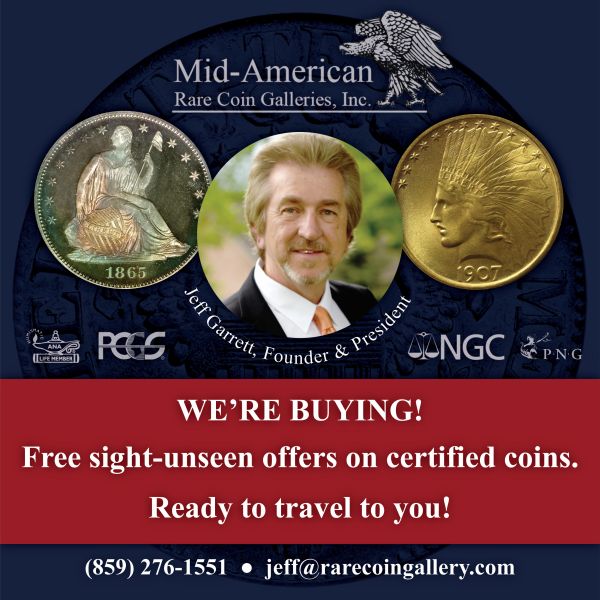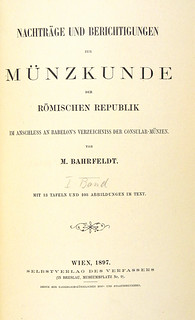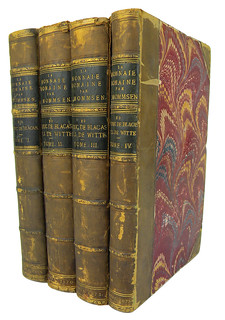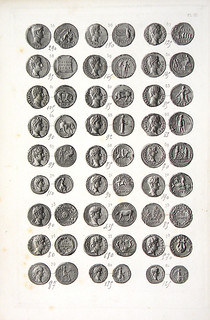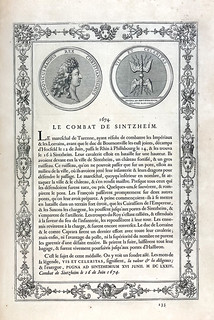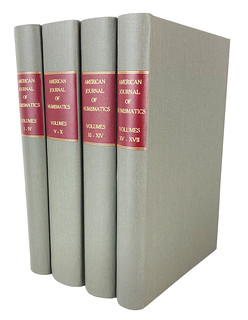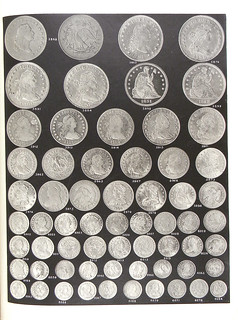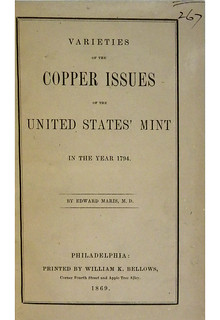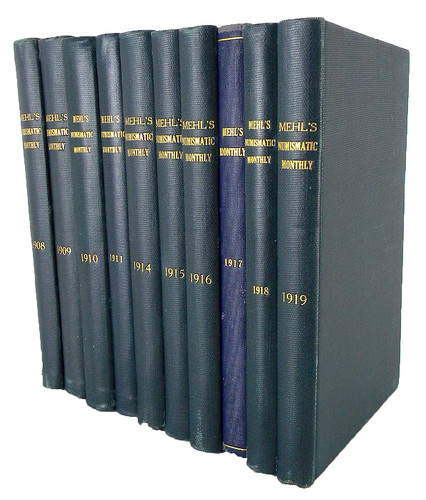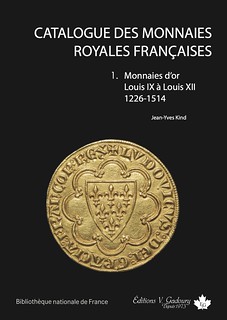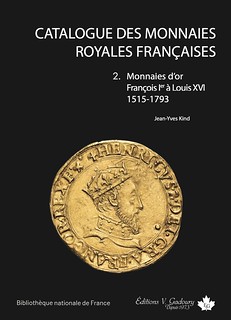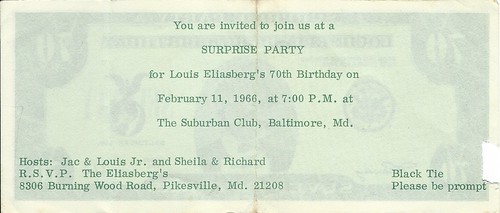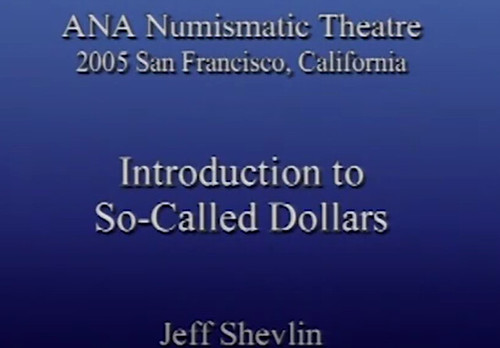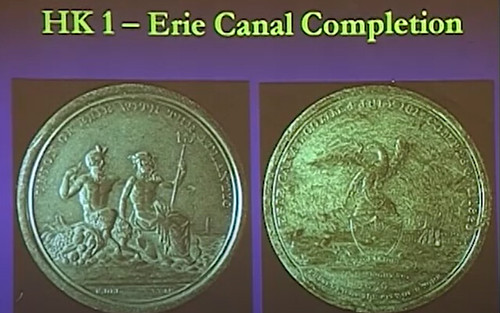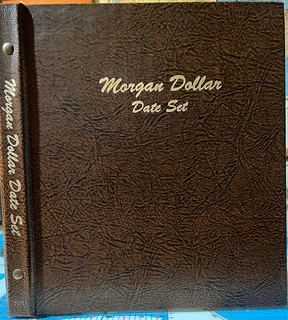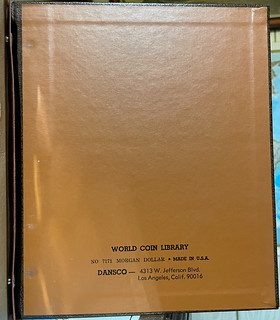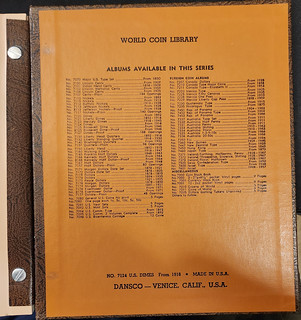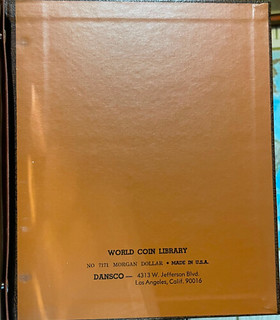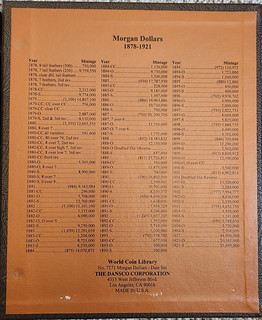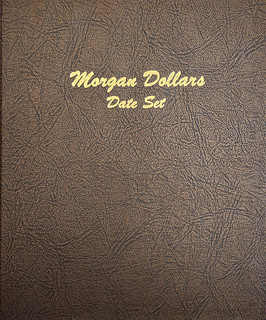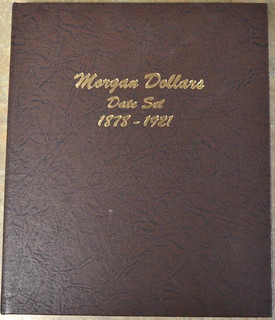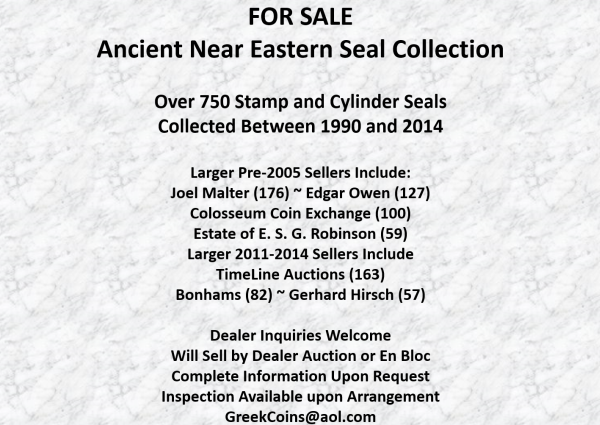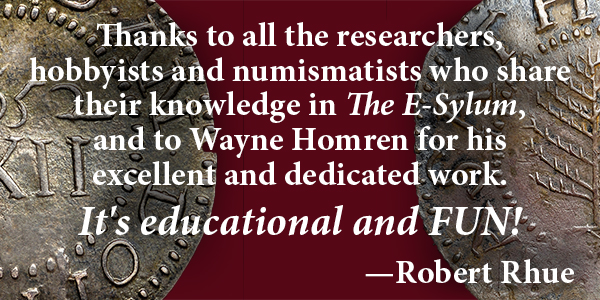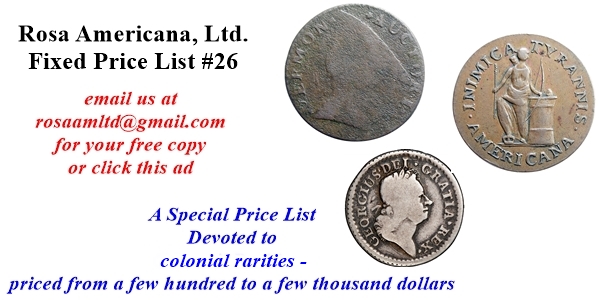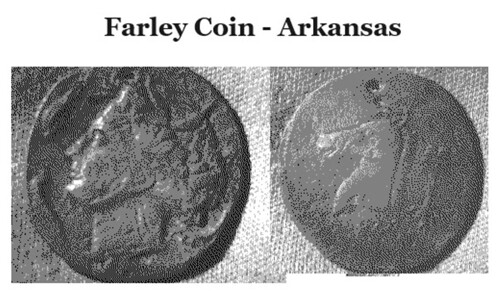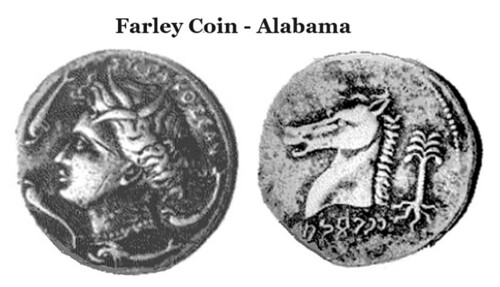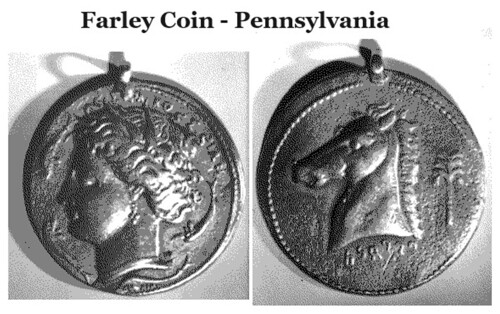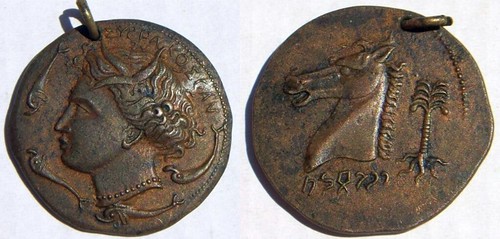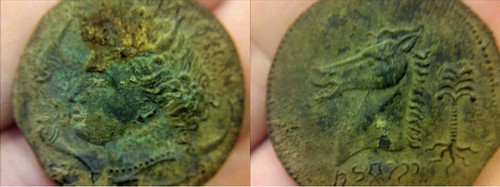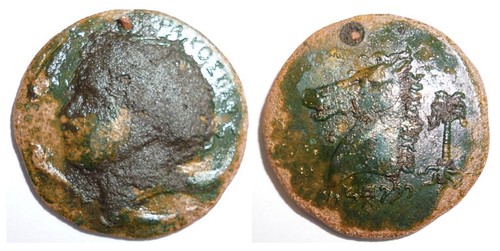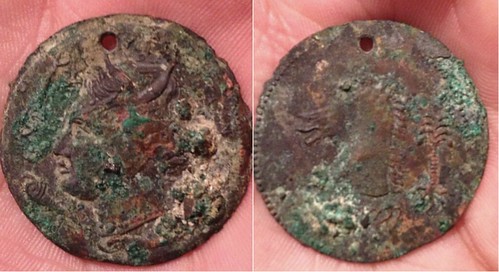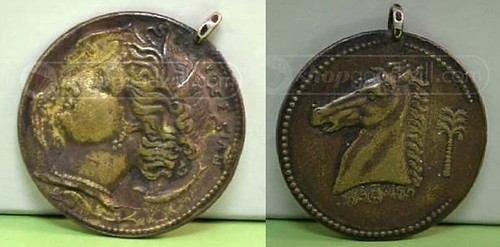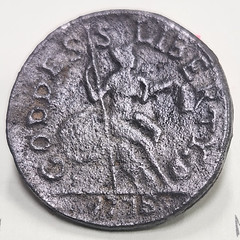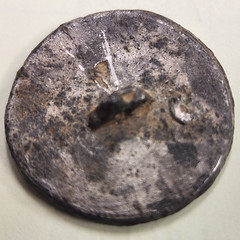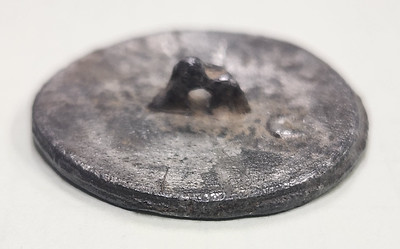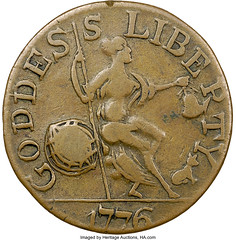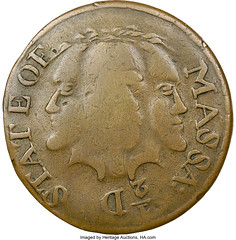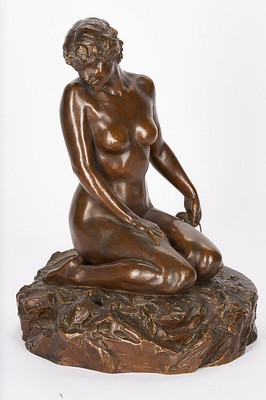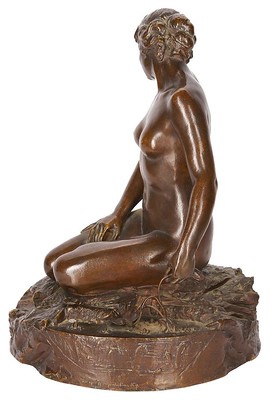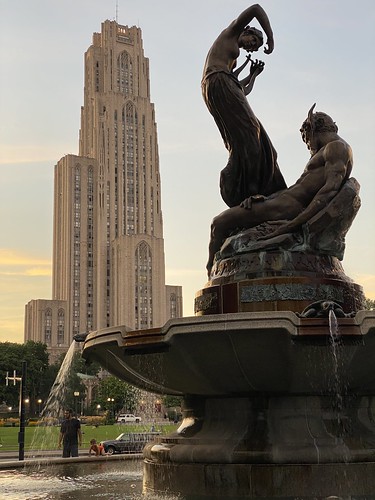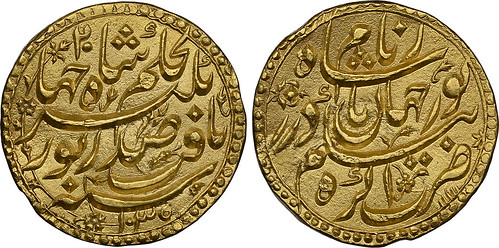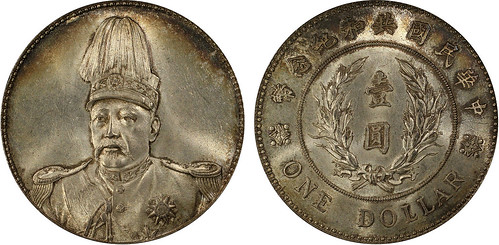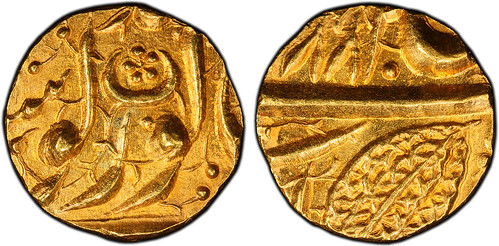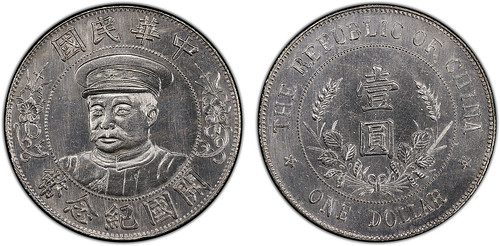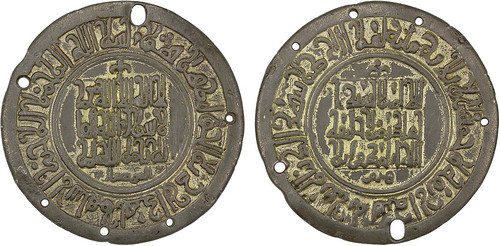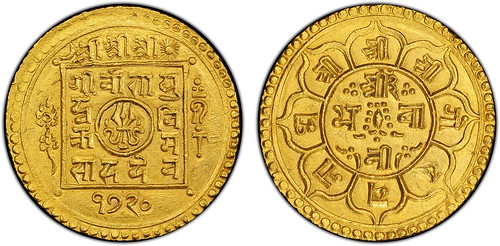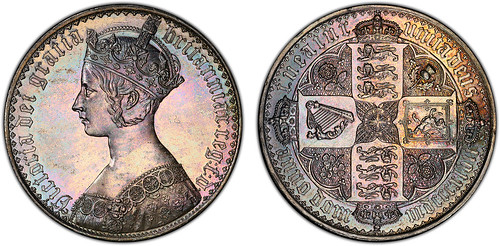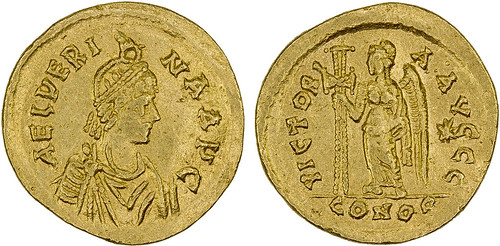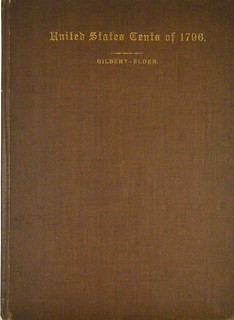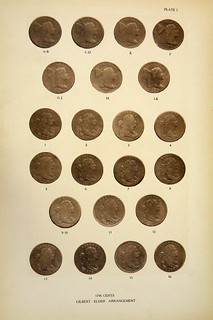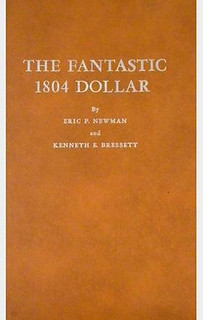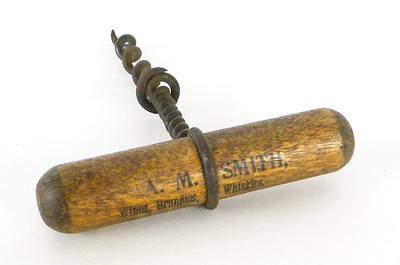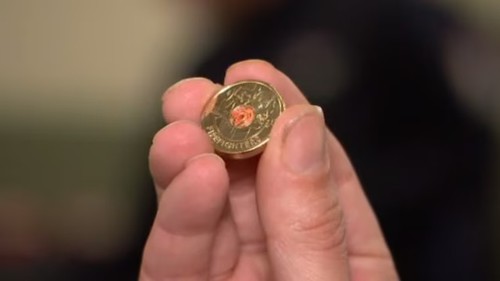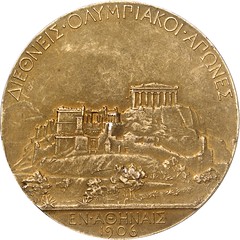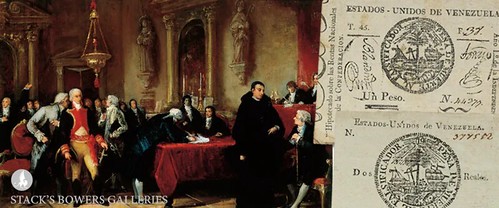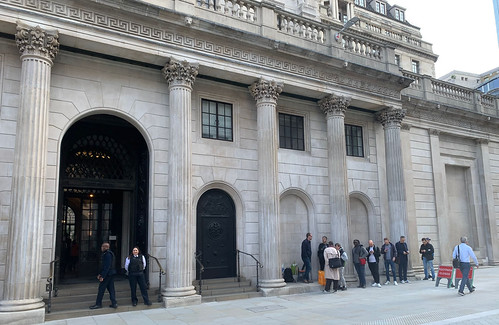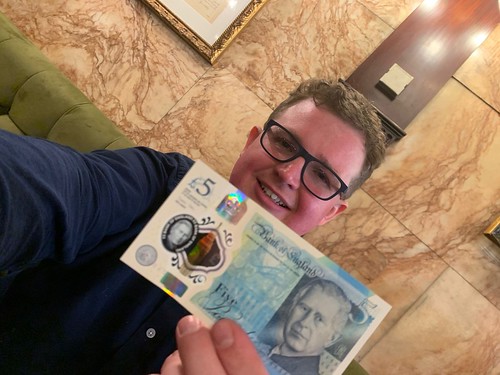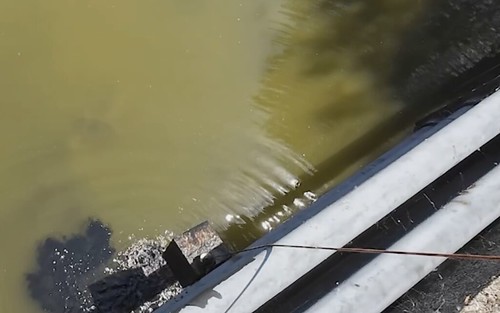
Visit our NBS Sponsors
About UsThe Numismatic Bibliomania Society is a non-profit association devoted to the study and enjoyment of numismatic literature. For more information please see our web site at coinbooks.org SubscriptionsThose wishing to become new E-Sylum subscribers (or wishing to Unsubscribe) can go to the following web page link MembershipThere is a membership application available on the web site Membership Application To join, print the application and return it with your check to the address printed on the application. Print/Digital membership is $40 to addresses in the U.S., and $60 elsewhere. A digital-only membership is available for $25. For those without web access, write to: Jeff Dickerson, Treasurer AsylumFor Asylum mailing address changes and other membership questions, contact Jeff at this email address: treasurer@coinbooks.org SubmissionsTo submit items for publication in The E-Sylum, write to the Editor at this address: whomren@gmail.com BUY THE BOOK BEFORE THE COIN |
- WAYNE'S WORDS: THE E-SYLUM JUNE 9, 2024
- MORE KOLBE & FANNING JUNE 2024 SALE SELECTIONS
- NEW BOOK: GUIDE BOOK OF U.S. PAPER MONEY 8TH ED.
- NEW BOOK: CATALOG OF FRENCH ROYAL GOLD COINS
- NEW BOOK: CORPUS OF MUGHAL COINS OF INDIA, VOL 3
- LOUIS ELIASBERG'S 70TH BIRTHDAY PARTY
- VIDEO: SO-CALLED DOLLARS
- DANSCO MORGAN MYSTERY
- NOTES FROM E-SYLUM READERS: JUNE 9, 2024
- PUBLISHER DENNIS TUCKER REFLECTS
- JOHN KRALJEVICH JOINS STACKS BOWERS
- VOCABULARY TERM: PLASTICS
- GLORIA STEWART FARLEY (1916-2006)
- THE FARLEY COINS
- REAL OR FAKE: FARLEY COINS
- A JANUS COPPER BUTTON?
- VICTOR DAVID BRENNER SCULPTURAL WORKS
- STEPHEN ALBUM RARE COINS AUCTION 49
- WAYNE'S NUMISMATIC LITERATURE JUNE 9, 2024
- ROYAL AUSTRALIAN MINT HOSTS COIN SWAP
- THE OLYMPIC GAMES THAT AREN'T RECOGNIZED
- THE FIRST PAPER MONEY OF VENEZUELA
- KING CHARLES III BANKNOTES ISSUED
- TOMMY THOMPSON IS STILL IN JAIL
- MAGNET FISHING YIELDS $100,000 IN CASH
- FEATURED WEBSITE: RHODE ISLAND CURRENCY
Content presented in The E-Sylum is not necessarily researched or independently fact-checked, and views expressed do not necessarily represent those of the Numismatic Bibliomania Society.
WAYNE'S WORDS: THE E-SYLUM JUNE 9, 2024
 New subscribers this week include:
Freeman Craig, courtesy Jeff Zarit; and
Dusan, courtesy Josef K.
Welcome aboard! We now have 7,257 subscribers.
New subscribers this week include:
Freeman Craig, courtesy Jeff Zarit; and
Dusan, courtesy Josef K.
Welcome aboard! We now have 7,257 subscribers.
Thank you for reading The E-Sylum. If you enjoy it, please send me the email addresses of friends you think may enjoy it as well and I'll send them a subscription. Contact me at whomren@gmail.com anytime regarding your subscription, or questions, comments or suggestions about our content.
This week we open with final selections from the June 15 Kolbe & Fanning numismatic literature sale, three new books, updates from the Newman Numismatic Portal, DANSCO albums, and more.
Other topics this week include collector Louis Eliasberg, So-Called Dollars, Dennis Tucker, John Kraljevich, Gloria Farley, Victor David Brenner, Tommy Thompson, an auction preview, the new King Charles III banknotes, magnet fishing, and Rhode Island currency.
To learn more about the Loco Foco Juggernaut
shinplaster, Mehl's Numismatic Monthly, the Royal gold coins of France, early numismatic photography, Farley coins, Calvin Westley Franklin, Don Miller, a rare numismatic auction broadside, the 1906 Olympics in Athens, and a
Janus Copper button, read on. Have a great week, everyone!
Wayne Homren
Editor, The E-Sylum
MORE KOLBE & FANNING JUNE 2024 SALE SELECTIONS

Here are additional selections from the next Kolbe & Fanning numismatic literature sale, featuring books on ancient, world and U.S. numismatics. which closes next Saturday. Get your bids in - some nice material here. -Editor
We are getting close to Kolbe & Fanning Numismatic Booksellers' next auction of rare and out-of-print numismatic literature from around the world, which will be held on Saturday, June 15. The sale includes a wide variety of books and other publications on ancient, world and U.S. numismatics, featuring material from the libraries of Wayne Homren and other consignors. Some highlights of this first sale include:
Lot 6: a complete set of Max Bahrfeldt's revision of Babelon on Roman Republican coins
Lot 94: the original 1865–1875 French edition of Théodore Mommsen's landmark Histoire de la monnaie romaine, ex the RBW Library
Lot 116: Rollin & Feuardent's 1887 catalogue of the collection of Roman & Byzantine gold coins belonging to the Vicomte de Ponton d'Amécourt
Lot 151: the expanded 1723 second edition of the extraordinary compendium of Louis XIV medals, featuring 318 finely engraved folio plates
Lot 224: two works by José Toribio Medina: Las monedas coloniales Hispano-Americanas and Las monedas coloniales de Chile, handsomely bound
Lot 282: the first seventeen volumes of the American Journal of Numismatics (1866–1883), bound in four volumes
Lot 386: an original Loco Foco Juggernaut
shinplaster, a rare and important satirical Hard Times note
Lot 311: a plated copy of Henry Chapman's massive 1921 catalogue of the John Story Jenks collection, from the library of Harry W. Bass, Jr.
Lot 409: the first separately published work on U.S. large cents, Edward Maris's 1869 Varieties of the Copper Issues of the United States Mint in the Year 1794
Lot 416: a complete set of Mehl's Numismatic Monthly (1908–1919), an important and scarce publication, being sold on behalf of the NBS.
Register early to bid online
Bids may be placed via post, email, phone, as well as online. Kolbe & Fanning use Auction Mobility as our third-party online bidding platform. Auction Mobility is an app-based platform allowing users the ability to participate in the sale through phones, tablets and computers. To register for the sale, bidders must go to
bid.numislit.com and sign up. Once you have set up an account, you may browse lots, place advance bids, or participate in the live sale online. Those wishing to participate on their devices can download the Kolbe & Fanning app through the Apple or Google Play Store. The sale will also be listed on Biddr and NumisBids in the near future.
The printed catalogue has been mailed to all active customers on our mailing list. As international mail speeds have been inconsistent, we encourage our foreign clients to consult the electronic catalogue in case their printed catalogue does not arrive promptly. A PDF of the printed catalogue has been posted to our main website at numislit.com for those who prefer that format. Bids placed via post, email, fax or phone must be received by June 14, the day before the sale, in order for them to be processed. Advance absentee bids may also be placed at any time online at bid.numislit.com. Live internet bidding will be available during the sale itself through the same platform.
Kolbe & Fanning Numismatic Booksellers LLC is a licensed and bonded auction firm in the State of Ohio, and our sales are conducted by licensed auctioneers. For more information, please see the Kolbe & Fanning website at numislit.com or email David Fanning at df@numislit.com. To register for the sale, go to bid.numislit.com. We look forward to your participation
To read the Catalogue PDF, see:
https://numislit.cdn.bibliopolis.com/images/upload/kolbefanningsale170.pdf
To read the earlier E-Sylum articles, see:
KOLBE & FANNING JUNE 2024 SALE ANNOUNCED
(https://www.coinbooks.org/v27/esylum_v27n21a03.html)
KOLBE & FANNING JUNE 2024 SALE SELECTIONS
(https://www.coinbooks.org/v27/esylum_v27n22a02.html)
NEW BOOK: GUIDE BOOK OF U.S. PAPER MONEY 8TH ED.
Here's the Whitman press release about the new edition of the Guide Book of United States Paper Money. -Editor
Currency is King: A Guide Book of United States Paper Money
Returns to Market in New Eighth Edition
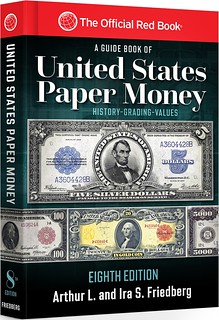 Whitman® announces the upcoming release of the newest edition of A Guide Book of United States Paper Money, by Arthur L. and Ira S. Friedberg. Paper-money collectors and American history buffs alike will appreciate the depth of the research, the fascinating narrative, and the wealth of data provided. The fully updated eighth edition builds on the critically acclaimed first through seventh editions, which have firmly established this book's reputation as a best-selling collector's price guide and history of U.S. federal paper currency from the Civil War era to date.
Whitman® announces the upcoming release of the newest edition of A Guide Book of United States Paper Money, by Arthur L. and Ira S. Friedberg. Paper-money collectors and American history buffs alike will appreciate the depth of the research, the fascinating narrative, and the wealth of data provided. The fully updated eighth edition builds on the critically acclaimed first through seventh editions, which have firmly established this book's reputation as a best-selling collector's price guide and history of U.S. federal paper currency from the Civil War era to date.
New features in this edition include the Top 100 U.S. Paper Money Prices Realized at Auction, 2022 and 2023.
Coauthor Ira Friedberg notes that this appendix shows how the upward movement of United States currency prices, especially for rarities and pieces in top condition, is continuing unabated—fueled not only by the entry of new collectors at all levels, but also by the realization that compared to United States coins, currency remains a relative bargain.
The 420-page softcover A Guide Book of United States Paper Money, eighth edition, can be pre-ordered now for $24.95 online at Whitman.com and Amazon.com, and will be available July 2024 at bookstores, hobby shops, Whitman's eBay Store, and other online retailers nationwide.
The Friedbergs have once again expertly improved upon a stalwart in the paper currency community,
said Whitman editorial director Diana Plattner after sending the book to press in March. Just as the book's subtitle asserts, this guide book continues to be a definitive source for history, grading, and values of U.S. paper currency.
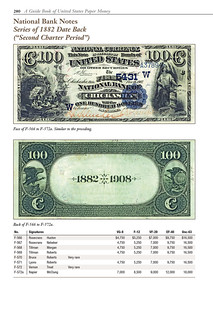 A Guide Book of United States Paper Money provides a catalog and price guide for federal notes from $10,000 down to $1 face value, Treasury notes of the War of 1812, encased postage stamps, Fractional Currency, error notes, and uncut sheets. It also covers hobby topics such as signatures on U.S. currency; grading standards; star notes; the Bureau of Engraving and Printing; how cash is designed, printed, and distributed; and how to collect, store, and care for collectible paper money.
A Guide Book of United States Paper Money provides a catalog and price guide for federal notes from $10,000 down to $1 face value, Treasury notes of the War of 1812, encased postage stamps, Fractional Currency, error notes, and uncut sheets. It also covers hobby topics such as signatures on U.S. currency; grading standards; star notes; the Bureau of Engraving and Printing; how cash is designed, printed, and distributed; and how to collect, store, and care for collectible paper money.
Authors Arthur and Ira Friedberg are well known in the numismatic world, having been professional numismatists for more than 30 years. Both joined their father's family firm, Coin & Currency Institute, after college. Since then, they have established themselves as award-winning authors, coin dealers, researchers, and numismatic consultants to numerous governments and organizations.
A Guide Book of United States Paper Money, 8th ed. • By Arthur L. and Ira S. Friedberg • ISBN 9780794850708 • Full color, 650+ photos • 6 x 9 inches, softcover, 420 pages • Retail $24.95
For more information, or to order, see:
A Guide Book of United States Paper Money, 8th Edition
(https://whitman.com/official-red-book-a-guide-book-of-united-states-paper-money-8th-edition/)
THE BOOK BAZARRE
NEW BOOK: CATALOG OF FRENCH ROYAL GOLD COINS
Editions V. Gadoury have published a two-volume work on the Royal gold coins of France. Here's the announcement. -Editor
CATALOGUE DES MONNAIES ROYALES FRANÇAISES TOME I et II
Author: Jean-Yves Kind
Publisher: BnF - Editions V. Gadoury
Year: 2024
€ 95.00
We are delighted to announce a wonderful surprise for all great enthusiasts of French numismatics.
We are honored and extremely happy to announce an exceptional collaboration with the Bibliothèque nationale de France (BnF) for the publication of the masterful work "CATALOGUE DES MONNAIES ROYALES FRANÇAISES" by Jean-Yves Kind, divided into two precious volumes.
The Department of Coins, Medals, and Antiques of the Bibliothèque nationale de France preserves the most extraordinary collection of French royal gold coins in its medal cabinets.
Almost the entire range of gold coinage struck during the reigns of Louis IX to Louis XVI is represented, with many specimens being exceedingly rare or unique to this day. This second volume of the "Catalogue des monnaies royales françaises en or," fully illustrated, is dedicated to the reigns of François I to Louis XVI.
Archivist and former special advisor for the Conservation of Treaties at the Ministry of Foreign Affairs, Jean-Yves Kind has been responsible for the collection of French coins at the Department of Coins, Medals, and Antiques of the Bibliothèque nationale de France since 2009. He is the author of numerous books and articles on numismatics, primarily published in the Revue numismatique and the Bulletin de la Société française de numismatique.
For more information, or to order, see:
CATALOGUE DES MONNAIES ROYALES FRANÇAISES TOME I et II
(https://www.gadoury.com/en/books/catalogue-des-monnaies-royales-francaises-tome-i-et-ii)
NEW BOOK: CORPUS OF MUGHAL COINS OF INDIA, VOL 3
Volume 3 in a series of books on the Mughal Coins of India has been published. -Editor
Corpus of Mughal Coins of India, Volume 3: Silver & Gold Coins in the names of Dawar Bakhsh, Shah Jahan I, Murad Bakhsh and Shah Shuja (1627-1659)
Nilesh Gada
Dilip Rajgor
 Corpus of Mughal Coins of India is a series of six volumes. The Corpus deals with all the coins issued by Mughal Emperors within modern countries of India, Pakistan, Afghanistan, Uzbekistan, Tibet, Nepal & Bangladesh from 1526 to 1858. These coins include not only all the coins issued by the Mughal Emperors, but also all the coins issued by provincial rulers in the name and style of these Mughal Emperors. These include Independent Kingdoms, Princely States and East India Company. Coins of each ruler are appended with actual photographs of a coin of both the sides. This has been supplemented along-with eye copies of the Persian legends as seen on the coins. For this black calligraphy pen is used to over-write on each segment of the legends on a coin. This helps in understanding how the legends or couplets on a given coin are arranged.
Corpus of Mughal Coins of India is a series of six volumes. The Corpus deals with all the coins issued by Mughal Emperors within modern countries of India, Pakistan, Afghanistan, Uzbekistan, Tibet, Nepal & Bangladesh from 1526 to 1858. These coins include not only all the coins issued by the Mughal Emperors, but also all the coins issued by provincial rulers in the name and style of these Mughal Emperors. These include Independent Kingdoms, Princely States and East India Company. Coins of each ruler are appended with actual photographs of a coin of both the sides. This has been supplemented along-with eye copies of the Persian legends as seen on the coins. For this black calligraphy pen is used to over-write on each segment of the legends on a coin. This helps in understanding how the legends or couplets on a given coin are arranged.
This is followed by in depth details of both the sides of a coin. For this, coin legend is written in Persian script to indicate the flow of the legends on the coin. To make it clear and lucid, a transliteration of the Persian script is also given in English.
Vol. 3 comprises of silver and gold coins issued from ninth to twelfth Mughal rulers, viz. Dawar Bakhsh, Shah Jahan I, Murad Bakhsh and Shah Shuja.
For more information, or to order, see:
Corpus of Mughal Coins of India, Volume 3: Silver & Gold Coins in the names of Dawar Bakhsh, Shah Jahan I, Murad Bakhsh and Shah Shuja (1627-1659)
(https://www.bagchee.com/books/BB138305/corpus-of-mughal-coins-of-india-volume-3-silver-gold-coins-in-the-names-of-dawar-bakhsh-shah-jahan-i-murad-bakhsh-and-shah-shuja-16271659)
To read the earlier E-Sylum articles, see:
NEW BOOK: CORPUS OF MUGHAL COINS OF INDIA, VOL 1
(https://www.coinbooks.org/v26/esylum_v26n41a04.html)
NEW BOOK: CORPUS OF MUGHAL COINS OF INDIA, VOL 2
(https://www.coinbooks.org/v27/esylum_v27n19a03.html)
LOUIS ELIASBERG'S 70TH BIRTHDAY PARTY
The latest addition to the Newman Numismatic Portal is an interesting piece of numismatic ephemera found in the Stan Kesselman papers. Project Coordinator Len Augsburger provided the following report. -Editor
Louis Eliasberg's 70th Birthday Party
From the Stan Kesselman papers, currently being processed by Newman Portal, comes this invitation to Louis Eliasberg's 70th birthday party in 1966. Eliasberg, Sr. (1896-1976) is well-known as the only collector to complete the United States coin series, less a couple asterisks that nit pickers breathlessly recall at a moment's notice. Nevertheless, the effort to recreate the legendary achievement of this Baltimore collector is now simply known as the Eliasberg quest.
The black tie
nature of the Eliasberg affair stands in contrast with the informality of the current generation, and it is hard to imagine today's coin dealers, not generally known for sartorial elegance, in such an environment. In any case, this delightful piece of ephemera harkens to a more traditional era, when a sense of fashion lent import to a milestone event.
Link to Stan Kesselman papers on Newman Portal
https://nnp.wustl.edu/library/archivedetail/552738
Link to Eliasberg's United States Gold Collection
sale (Bowers & Ruddy, 1982):
https://nnp.wustl.edu/library/auctionlots?AucCoId=510373&AuctionId=520557
Link to Eliasberg auction sale catalog (Bowers & Merena, 1996)
https://nnp.wustl.edu/library/auctionlots?AucCoId=4&AuctionId=525063
Link to Eliasberg auction sale catalog (Bowers & Merena, 1997):
https://nnp.wustl.edu/library/auctionlots?AucCoId=4&AuctionId=525069
Link to Eliasberg auction sale catalog (ANR, 2005):
https://nnp.wustl.edu/library/auctionlots?AucCoId=1&AuctionId=517705
VIDEO: SO-CALLED DOLLARS
The David Lisot Video Library on the Newman Numismatic Portal can be found at:
https://nnp.wustl.edu/library/multimediadetail/522852
We highlight one of his videos each week in The E-Sylum. Here's one from 2005 with Jeff Shevlin speaking about So-Called dollars. -Editor
Learn about So-Called dollars. These medals are about the size of a US silver dollar and were struck to commemorate significant events in history. This presentation includes:
- Definition of a So-Called dollar
- Categories that include fairs & exhibitions and historical events
- How some events had dozens of different pieces struck
- Explanation of why different pieces were struck, in what quantities and in what metals
- Some of the activities including the Erie Canal, World's Columbian Expo, Trans-Mississippi, Wells Fargo, Continental Dollar restrikes, Louisiana Purchase, San Francisco earthquake, Jamestown, Panama Canal, Wilson Dollars, Pan-Pac Expo and more
- The debate over whether So-Called dollars should be slabbed
Speaker: Jeff Shevlin. Publication date: August 20, 2005.
To watch the complete video, see:
Introduction to So-Called Dollars
(https://youtu.be/WqgWA_t9GaY)
DANSCO MORGAN MYSTERY
James Higby of Dixon, Illinois writes:
"Some time ago I ordered two Dansco 7171 albums for a date set of Morgans.
"One has the usual format, titled "Morgan Dollars Date Set" on cover and spine, the front pastedown having a lengthy discussion of the series, and the rear pastedown having a complete listing of all Morgans by date-and-mint, with mintages of each. The company name and address in Los Angeles are below that. This one was bought from a coin supply dealer years ago.
"The other reads "Morgan Dollar [sic] Date Set", with the same on the spine. The front pastedown is completely blank, and the rear pastedown has only the company name and address, again in Los Angeles. This one was bought recently in brand-new condition off eBay.
"Both have "7171" at the bottom of the spine.
"I'm wondering what is going on here."
I reached out to "Dancso Dude" Justin Hinh for comment. Here's his response. -Editor
What James noticed are format changes Dansco has made to their albums over the past 58 years. These changes hint as to when the album was printed.
Dansco first started producing their brown albums in 1966. The telltale sign that you have a vintage album is the back binder listing Dansco's then-existing catalog as well as Venice, California being the printing location. There were two vintage formats. One with one column, and another with two columns.
Here is the back of my #7240 Cuba Type and #7124 U.S. Dimes. Notice the copyright year and "Venice, Calif"
When Dansco moved from Venice, CA to Los Angeles, CA around 1979, they updated the format to remove the catalog and left it mostly blank.
At some unknown date, they updated the back binder again to include the year and mintage for the coin series.
In the case of the #7171 Morgan Dollars Date set album, they updated it again but this time only on the front to include the years covered.
Given the popularity of Morgan Dollars and Dansco's move to Sumas, Washington, I would not be surprised to hear Dansco reprint #7171 but update the format to reference Sumas rather than Los Angeles.
In short, Dansco albums have changed over the years. It's an interesting glimpse into the past, but value-wise there is no premium in the market for older versions of albums. What matters most is what coin series the album covers, especially if it's a non-commonwealth foreign album i.e. Cuba, Panama, New Guinea, etc. These albums easily go for hundreds of dollars empty.
This is what curious collectors do - collect, observe, and solve mysteries. Thank you! -Editor
NOTES FROM E-SYLUM READERS: JUNE 9, 2024
James Risk's Orders and Decorations Identified
Marc Ricard writes:
"As a collector of medals, badges, orders, and decorations, I was able to use my reference library to identify the rest of James C. List's Orders and Decorations. I hope this helps our readers and fellow collectors to appreciate the skill required to create such beautiful masterpieces."
Thank you! Here's the image again followed by Marc's identifications. E-Sylum readers are the best. -Editor
Miniature Medals in Display Box – left to right
- U.S. American Defense Service Medal
- U.S. American Campaign Medal
- U.S. European-African-Middle Eastern Campaign Medal
- U.S. Victory Medal – WWII
- U.S. Army of Occupation Medal of Germany and Japan – WWII
- U.S. Naval Reserve Medal (pre-1958)
- Italy – Knight of the Order of Saints Maurice and Lazarus
- Italy – Commander of the Order of the Crown of Italy
- Italy – Knight Commander of Grace of the Sacred Military Constantinian Order of St. George of Italy
- Vatican – Papal Lateran Cross (pre-1977)
Large Decorations on the Rectangular Blue Pad
- Top Left – Italy - Knight Commander of Grace of the Sacred Military Constantinian Order of St. George. Neck Badge (missing light blue ribbon)
- Top Right – Italy – Commander of the Crown of Italy. Neck Badge (missing red and white neck ribbon)
- Middle Right – Italy - Knight Commander of Grace of the Sacred Military Constantinian Order of St. George. (Informal Jacket Breast Pin)
- Bottom Center – Italy - Knight Commander of Grace of the Sacred Military Constantinian Order of St. George. Knight Commander Breast Star (worn on light blue Knight Sash)
To read the earlier E-Sylum article, see:
NOTES FROM E-SYLUM READERS: JUNE 2, 2024 : On James Risk's Orders and Decorations
(https://www.coinbooks.org/v27/esylum_v27n22a09.html)
Uncashed One Cent U.S. Treasury Check
Erik Goldstein writes:
"Sometime around 1920 my great grandfather started Morgan Steel Corporation,
which had become one of the largest steel warehouses in New York City by WWII. After the war, my grandfather bought a few hundred surplus oxy-acetylene torch regulators from the U. S. Navy, at the nearby Brooklyn Navy Yard. A bookkeeper (probably one of my aunts or uncles) accidentally overpaid the Navy's invoice, and they issued this ridiculous refund check. Rather than cash the thing, it was framed and hung up in the office. I was always fascinated & amused by it, so when my dad closed Morgan's doors in the early 1990s, he gave it to me. Now it hangs above my desk!"
Cool! Absurd, but still cool. Thanks - neat item. -Editor
To read the earlier E-Sylum article, see:
NOTES FROM E-SYLUM READERS: JUNE 2, 2024 : Uncashed 1919 U.S. Treasury Check
(https://www.coinbooks.org/v27/esylum_v27n22a09.html)
David Fanning on Early Numismatic Photography
"I am a lifetime member of the Numismatic Bibliomania Society (since 2023), and I have enjoyed your weekly E-Sylum very much.
"On June 6, 2024, I attended the New York Numismatic Club (NYNC) meeting as a guest of Mr. David Fanning, who gave the presentation, "Early Numismatic Photography, 1849- 1869." At the meeting, not only was it great for me to see my good friend, David, I also had the wonderful opportunity to finally meet with Len in person. Here's a picture that was taken of us at the meeting."
Thank you - a great club and event. Thanks for sharing. Sounds like a memorable night of numismatic knowledge and fellowship. -Editor
Sam Arias to Speak on the Bank Tokens of Canada
Judy Blackman of the Manitoba Coin Club submitted this invitation to an upcoming talk by an up-and-coming young numismatist. Thanks - mark your calendars. -Editor
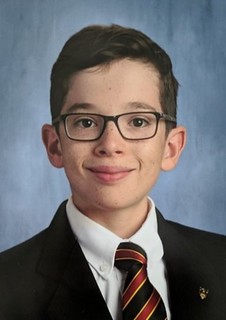 Tracy Arias (parent) and Sam Arias (son) have both consented to this information and image being shared with The E-Sylum readers. It's not that often that we have the opportunity to support a Young Numismatist as they progress in the numismatic community.
Tracy Arias (parent) and Sam Arias (son) have both consented to this information and image being shared with The E-Sylum readers. It's not that often that we have the opportunity to support a Young Numismatist as they progress in the numismatic community.
Sam Arias became a member of the Manitoba Coin Club in September 2023 at the age of eleven. Sam is grateful for the knowledge and friendships that he has gained as a member of the Manitoba Coin Club. Sam began collecting coins at the age of six when he received his grandfather's Canadian coin collection. Since that time, Sam has greatly added to the collection and has also started to collect banknotes and foreign coins. Sam enjoys collecting because his coins and banknotes provide tangible representations of history. Besides collecting coins, Sam spends his time reading, metal detecting, and playing the viola and piano.
On Saturday, September 14th , 2024 at 2PM (CST), at the Winnipeg Mint, 12-year-old Sam Aris will be speaking at the Manitoba Coin Club meeting (accessible in-person and by Zoom) on The Bank Tokens of Canada
providing insight into Canada's complex political history between 1837 to 1857. Visit website for future coin show and meeting dates
http://www.manitobacoinclub.org/.
E-Sylum readers who wish to join by Zoom can use this link: https://us06web.zoom.us/j/84156832688?pwd=ZzV4VmdaTEZZS3NpSzJORDdXZTltdz09 Meeting ID: 841 5683 2688, Passcode: 313227, Find your local number: https://us06web.zoom.us/u/khpoaQUfD .
Check it out folks - Canadian Bank tokens are a great topic. -Editor
PUBLISHER DENNIS TUCKER REFLECTS
An article on Worthpoint interviews numismatic publisher and author Dennis Tucker, who recently retired from Whitman Publishing. Here's an excerpt - see the complete article online. -Editor
 In 2004, Tucker joined Whitman Publishing and helped lead the
In 2004, Tucker joined Whitman Publishing and helped lead the modern renaissance
in numismatic publishing by issuing many titles on the coin market, banking, and US financial history. Most importantly, he helped publish twenty editions of the Red Book, known by those in the hobby as the single most important reference work for US coinage.
Now, two decades later, Tucker's recent retirement from that longtime role has made waves among coin collectors and dealers everywhere. Although he is no longer a publisher by title, Tucker remains very involved in the field. In addition to finishing his term aboard the Treasury Department's Citizens Coinage Advisory Committee, Tucker is still regularly attending coin-related events, like the Central States Numismatic Society's Convention in April, where he received the organization's Q. David Bowers Lifetime Achievement Award. Tucker is also spending his time leading the board of directors of the nonprofit Brayhope Farm, which provides programs for autistic children and others in need.
In a recent interview with WorthPoint, Tucker reflected on his career, how he got started, and what he's looking forward to in the numismatics hobby.
I wrote occasional letters to the editor of the hobby papers, corresponded with dealers and other collectors, and collected mainly through mail-order. In my late twenties, I was in the right place at the right time to purchase a couple of very large collections of medals, which I organized, studied, cataloged, and sold for a profit. My passion was more as a student of numismatics, though, not as a dealer.
When the opportunity came to join Whitman Publishing as the company's publisher, I was thirty-two years old and had more than twenty years of experience in the hobby. By that time, I'd built my career in corporate communications, public relations, and publications management. I'd taken a detour into the nonprofit world and was looking to get back into the corporate arena when I was offered two positions in the same week: as a director of communications for Coca-Cola North America and as publisher at Whitman. Both were headquartered in Atlanta, where I'd moved a few years earlier. If you've ever lived in Atlanta, you know that Coca-Cola is huge here, and I was thrilled to be offered such an important position. On the other hand, the idea of working at Whitman Publishing, with authors I'd read since I was a kid, and with books that were crucial to my own development as a collector … I wouldn't say it was an easy decision, but Coke didn't really have a chance.
It's hard to say exactly where, along that path, I was first deeply involved in numismatics. It was a natural, gradual process of learning more and more, getting deeper and deeper into both the hobby and the industry. Certainly, 2004, when I started working at Whitman Publishing, was a tipping point to a new level.
Working with Dave Bowers has been one of the major highlights of my numismatic career. His books were among the first I read about coins and paper money, as a young collector, so I'd been his student for many years by the time we finally met. Our introduction was by phone, shortly after I was hired as Whitman's publisher. We had a wonderful conversation. A few minutes into it, he told me, If you keep calling me ‘Mr. Bowers,' I'm going to call you ‘Mr. Tucker'!
and from that point on we've been on a first-name basis.
To read the complete article, see:
PUBLISHER DENNIS TUCKER REFLECTS ON LONGTIME NUMISMATIC CAREER
(https://www.worthpoint.com/articles/collectibles/publisher-dennis-tucker-reflects-on-longtime-numismatic-career)
JOHN KRALJEVICH JOINS STACKS BOWERS
John Kraljevich is a good friend and prolific numismatic researcher, author and cataloguer. Long associated with Dave Bowers and Stack's Bowers Galleries, he's now joining the firm fulltime. Here's the announcement. -Editor
Stack's Bowers Galleries Appoints John Kraljevich Director of Numismatic Americana
Veteran Consultant to Take Full Time Role
 Stack's Bowers Galleries proudly announces the appointment of John Kraljevich to the newly created position of Director of Numismatic Americana. Kraljevich, proprietor of John Kraljevich Americana since 2007, has been recognized as one of the most influential figures in numismatics. Coin World honored him in their inaugural list of Most Influential People in Numismatics, and he was distinguished as one of the
Stack's Bowers Galleries proudly announces the appointment of John Kraljevich to the newly created position of Director of Numismatic Americana. Kraljevich, proprietor of John Kraljevich Americana since 2007, has been recognized as one of the most influential figures in numismatics. Coin World honored him in their inaugural list of Most Influential People in Numismatics, and he was distinguished as one of the Top 14 Numismatists of the Century
by CoinAge magazine. In his new role, Kraljevich will devote his numismatic talents to cataloging noteworthy consignments across a wide range of specialties for Stack's Bowers Galleries auctions. In addition, he will maintain an inventory of historical American numismatic items for retail sale and work with the firm's collector and dealer clients.
Kraljevich embarked on his full-time career in numismatics in 2000 as a cataloger and professional numismatist at Bowers and Merena Galleries of Wolfeboro, New Hampshire. His tenure at Bowers and Merena, American Numismatic Rarities, and Stack's (where he specialized in early American coins and numismatic Americana), laid the foundation for his illustrious career. Since establishing John Kraljevich Americana, he has continued to collaborate with Stack's Bowers Galleries as a consultant, earning acclaim for his cataloging prowess and subject matter expertise.
Reflecting on his journey, Kraljevich remarked, Since the age of 22, the team at Stack's Bowers Galleries has been like family to me. Dave Bowers and Larry Stack have been invaluable mentors over the decades. Though the company name has evolved, the professionals I have worked with day in and day out for years and the firm's commitment to excellence have remained constant. I am eager to continue contributing to the rich tapestry of numismatic history on behalf of our esteemed clients.
Brian Kendrella, President of Stack's Bowers Galleries, expressed his enthusiasm for the appointment: John's name is synonymous with expertise, integrity, and captivating storytelling in the realm of numismatics. I am proud to offer our clients access to the most talented staff in the hobby, and I am sure every sophisticated collector of historical American coins and exonumia will want to utilize John's expertise to add value to their collections."
In addition to Stack's Bowers Galleries' presentation of the D. Brent Pogue Collection, the most valuable coin collection ever sold, Kraljevich has cataloged many of the firm's most legendary auction presentations, including the Louis E. Eliasberg, Sr. Collection of World Gold Coins, the Lucien LaRiviere Collection of Betts Medals, the El Dorado Collection of Colombian coins, the John W. Adams Collection of Comitia Americana Medals, the Cardinal Collection of Early Dollars, the John J. Ford, Jr. Collection of Canadian Colonial Tokens, the Norweb Collection of Washingtoniana, the Ted Craige and Archangel collections of colonial coins, and many more. Throughout his career, Kraljevich has authored more NLG award winning catalogs than any other writer in history.
Beyond cataloging, Kraljevich has contributed to the Guide Book of United States Coins and dozens of numismatic reference books, including 100 Greatest American Medals and Tokens, and The Early Paper Money of America by Eric Newman, as well as other works by Q. David Bowers and others.
A well known numismatic personality, for over 30 years Kraljevich has delivered lectures at prestigious institutions such as the American Numismatic Society and the American Numismatic Association's Summer Seminar as well as to non-numismatic organizations.
A fixture in both numismatic and mainstream media, Kraljevich has shared his insights through interviews with prominent outlets including the Washington Post, National Public Radio, and the BBC. Recognized for his contributions to the field, he has been honored with multiple awards from the American Numismatic Association, including the Young Numismatist of the Year award (1993), the Heath Literary Award (2002), an Honorary Doctorate of Numismatics (2015), the Numismatist of the Year award (2016), and the Medal of Merit (2018). In 2022, Kraljevich received the Numismatic Literary Guild's Ribbit Award for "an individual who has achieved prominence in numismatics while maintaining approachability, a sense of humor and essential modesty.
A native of Chester County, Pennsylvania, Kraljevich is a graduate of the University of Virginia and currently resides in Alexandria, Virginia. Kraljevich can be reached by email at JK@StacksBowers.com.
I've known "JK" since he was an up-and-coming young numismatist, and it was him who came to collect and catalog my consignment for the 2006 American Numismatic Rarities sale that helped us purchase our Northern Virginia home. I'm excited and delighted to have him come to this area, and look forward to continued numismatic fellowship. Good luck and congratulations on the new position. -Editor
VOCABULARY TERM: PLASTICS
Here's another entry from Dick Johnson's Encyclopedia of Coin and Medal Terminology. -Editor
Plastics. A wide class of materials made of chemical polymers and other components, both natural and synthetic (including resins, caseins and such). Medallic items have been made of plastics – often in color (by adding a dye to the plastic) – and formed by molding or casting. The composition is more suitable for such items as sales tax tokens; these were made of plastics in America shortly after World War II. Plastics was infrequently considered as a coin or medal composition substitution in wartime.
Plastic Coin. Pattern cents in plastic were made in the United States in 1942, but for many reasons it was not a serious coin media. The U.S., of course, chose a zinc-coated steel cent as the substitute composition in World War II.
Plastic Medal. The Rochester Numismatic Association had a custom of issuing a medal for each club president since 1913. It continued the tradition, even in difficult times of the depression. But for World War II bronze was a strategic war material and unavailable for medals. It prepared the dies for the presidents during the war and issued a plastic medal at the time, replacing these with bronze medals when the material became available after the war.
See also bakelite, epoxy, thermoplastic.
So, are there any wartime Rochester Numismatic Association plastic medals still around? In what year(s) were they prepared? Are there any photos? -Editor
Len Augsburger writes:
"The Rochester model must have been based on the New York Numismatic Club, which issued president's medals in 1910 and 1912."
Marc Ricard writes:
"I have a complete set of the bronze RNA Presidential medals, but I don't have any of the plastic issues."
To read the complete entry on the Newman Numismatic Portal, see:
Plastics
(https://nnp.wustl.edu/library/dictionarydetail/516508)
GLORIA STEWART FARLEY (1916-2006)
E-Sylum Feature Writer and American Numismatic Biographies author Pete Smith submitted a group of three articles on "Epigraphic Explorer" Gloria Farley and the enigmatic "Farley Coins". Thanks! -Editor
This article was inspired by Julia Casey who reported on Farley coins
found in America and attributed to Carthaginians who visited America before Columbus. Thanks also to William E. Daehn who helped with the description of Greek coinage.
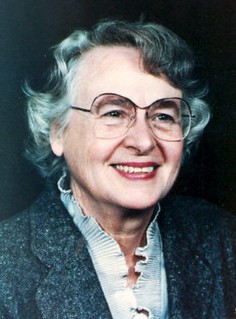 Gloria Farley was not a numismatist. She was called an Epigraphic Explorer, a term probably understood by fewer people than the term numismatist. Epigraphy is the study and interpretations of ancient inscriptions.
Gloria Farley was not a numismatist. She was called an Epigraphic Explorer, a term probably understood by fewer people than the term numismatist. Epigraphy is the study and interpretations of ancient inscriptions.
She was born Gloria Stewart in Heavener, Oklahoma, on October 21, 1916, and spent most of her life there. Her father was a physician, Dr. Matthew Albert Stewart (1876-1947). Her mother was Eunice Virginia Upchurch Stewart (1890-1967).
When Gloria was twelve in the spring of 1928, she visited Poteau Mountain to see an upright stone slab inscribed with mysterious glyphs. This was known at the time as Indian Rock.
Her guide was Carl F. Kemmerer who had discovered the stone in 1913. Also on the visit was Kemmerer's daughter Rosemary.
A couple of years later Rosemary saw an article on Runic writing in a Sunday School newspaper and remembered their visit to the site. Gloria rediscovered the stone on February 2, 1951, and named it the Heavener runestone. This began her thirty-five year search for the truth.
Gloria quit college after one year to marry Jasper Ray Farley (1914-1983) on March 28, 1937. They had two sons, Mark and Scott. They lived in Missouri for two years and at Washington Court House, Ohio, for eleven years before returning to Heavener in 1950 when Ray was appointed city manager. The population at the time was 2103.
In 1948, Gloria read about the Kensington Runestone in Minnesota. She wrote to the Smithsonian about the Heavener Runestone inscription and they had a previous 1923 report from Carl F. Kemmerer. Gloria began to study similar stones in Oklahoma and around the area. She took photographs and made latex molds for plaster casts. Some of the stones she studied have been subsequently moved or lost.
In 1953, she began work as a kindergarten teacher, conducting classes in her home. The class that year had ten students. In 1963 she was employed as a caseworker with the LeFlore County Department of Public Welfare.
In 1965, the Heavener Runestone location with 55 acres was donated by Herbert Z. Ward to the public and the Heavener Runestone State Park opened in 1970. The eight-character inscription on the stone has various translations, one of which is Glome's Valley.
In 1971, Gloria announced the discovery of two more Viking runestones in Oklahoma, bringing the total in the state to nine. The inscriptions were translated by Alf Monge. Some of the stones are believed to include dates represented as puzzles. One explanation of the Heavener Runestone is a cryptographic date of November 11, 1012. Her reports were not broadly accepted.
Dr. Ole G. Landsverk wrote Ancient Norse Messages on American Stones, published in 1969. He said, opponents have been blinded by an attitude that if a Runestone is not in Scandinavia it is not authentic.
Landsverk believed the Oklahoma inscriptions were carved by the same priest who carved a Runestone found near Byfield, Massachusetts.
It was about 1975, that Gloria learned of Barry Fell, a fellow traveler down the paths of epigraphy. Fell also believed that stone inscriptions were the work of Europeans here before Columbus. The two became mutually supportive. In 1977, Fell named Farley as Director of Exploration for the Epigraphic Society. The general academic community views his work as pseudoscience.
In 1976 Gloria was presented with a coin found in Arkansas that was identified as coming from Carthage and struck from 320 to 300 B.C. An article was included in the January 29, 1978, Sunday supplement Family Weekly, distributed with local papers. After this article appeared, readers reported other examples. These have become known as Farley Coins.
The coins have the general appearance of a Carthaginian Tetradrachm struck around 320 to 300 B.C. The obverse has the head of Arethusa and the reverse has a horse head and uprooted palm tree. Experts consulted by Farley determined they were genuine. In my opinion, they can be easily seen to be modern fantasies.
Gloria Farley did not limit her study to Viking runestones. She searched honored for research on the Oklahoma Runestone inscriptions.the country for ancient inscriptions in various languages including Egyptian, Libyan, Basque, and Phoenician. She wrote many articles and lectured around the country.
In 1982 she was inducted into the Oklahoma Women's Hall of Fame as an Epigraphic Explorer and
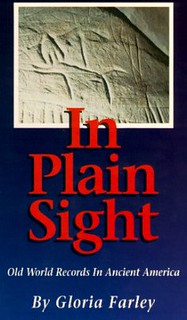 Her book, In Plain Sight: Old World Records in Ancient America was published in 1994. This included descriptions of seven
Her book, In Plain Sight: Old World Records in Ancient America was published in 1994. This included descriptions of seven Farley Coins.
More were reported after publication of the book.
She was a fellow of the Epigraphic Society and the Explorers Club. In 2000, she was presented with the Barry Fell Award by the Midwestern Epigraphic Society. Fell died in 1994 and has generally been discredited.
Gloria Farley died in Heavener on March 18, 2006, and is buried with her husband at Hill Cemetery.
On April 17, 2006, the Oklahoma State Senate passed Senate Resolution 87 which stated, Farley's tireless work and efforts have produced a wealth of historical knowledge and ultimately resulted in her research area being transformed into the Heavener Runestone State Park.
The study of pre-Columbian visits to America has always been controversial. Proponents hold to their beliefs and interpret evidence in their favor. Opponents dismiss these as wishful thinking, poor science, and occasionally intentional deception.
THE FARLEY COINS
Here's the second of Pete Smith's three articles on "Epigraphic Explorer" Gloria Farley. This one focuses on the "coins" themselves. -Editor
In her 1993 book, In Plain Sight: Old World Records in Ancient America, Gloria Farley wrote about seven similar coins believed to be evidence of ancient visits to America before Columbus. They are named for the states where they were found.
Farley Coin: Arkansas
Jessie Ray Kelley found the coin with a metal detector in 1973 in a field near Cauthron, Arkansas, about 19 miles east of Heavenor, Oklahoma. It was sent to Boston for examination by Dr. Norman Totten, He wrote:
The coin is bronze, imperfectly round, measuring 29.5 by 25.0 millimeters in diameter, and weighing 7.63 grams. It has suffered from corrosion. There is no question of its antiquity or its authenticity. The patina on the coin and in the hole has several colors: green, oxblood, yellow and tan. Indications are that it has been buried for centuries.
Farley Coin: Alabama
The coin was found by a small boy in Alabama in 1957. It appears to match the style of the Arkansas coin. It is not holed and the only one of the seven that is not a jewelry piece.
Farley Coin: Kansas
Eddie Thornton reported finding a coin with a metal detector in 1976 buried six inches deep. It has a hole at the top. It matches the style of the Arkansas coin.
Farley Coin: Pennsylvania
Mini Frank wrote to Farley about a coin she had worn as a pendant since she was five. This piece was about the size of a quarter and had a palm tree with no roots. She had been given the pendant by a gypsy woman. This is smaller than the previous pieces and a jewelry piece rather than a ground find.
Farley Coin: Connecticut
Frederick J. Gastonguay of Waterbury, Connecticut, sent a photo to Dr. Totten. He had carried it in his pocket for twenty years after finding it in a field near Waterbury. This matched the style of the Arkansas coin.
Farley Coin: Nebraska
This coin was reported in 1981 but had been found about 1926. It was found by Delsa Knapp when she was about five years old. She found it at the bottom of a hole her brothers had dug in a cave on a tributary of the North Platte River. There is a hole at the top. Dr. Totten confirmed it was authentic.
Farley Coin: Georgia
This coin was found in Columbus, Georgia, on February 1, 1986, by John Carroll. It was found across the Chattahoochee River from the Alabama coin. It was found with a metal detector about 13 inches below the surface. The coin is holed for suspension and the palm tree has five roots.
Other Farley coins were reported after publication of the original list of seven. There has been discussion of them among metal detecting hobbyists but not among numismatists.
Dr. Mark McMenamin wrote Phoenicians, Fakes and Barry Fell, published in 2000. An abstract of the book stated, In this book, Mark McMenamin demonstrates that putative Carthaginian coins found scattered across the United States (the
Farley Coins
) do not date back to antiquity but are in fact provocative (i.e., uprooted palm tree devices) forgeries, possibly produced and scattered to confound researchers with archaeological ‘fake news.'
In 2009 Mark McMenamin reported that Eleven specimens are known, from five different die varieties.
Presumably, this total includes the specimens on the Farley list plus additional specimens located by McMenamin, including:
Farley Coin: Northampton, Massachusetts (McMenamin)
McMenamin inspected this coin in 2000. McMenamin described it as from the same or very similar dies that still retained mint luster under a lacquer coating.
Additional finds are noted by contributors to Treasurenet.com:
Farley Coin: Wisconsin (Treasurenet)
This coin was reported in 2009 to have been found by Dale Brennan many years earlier while he was metal detecting as a child. Brennan stated it was 29mm and 10 grams.
Farley Coin: Connecticut (Treasurenet)
Ugotit22 reported that he found this coin in the yard of an 1800s farmhouse.
Farley Coin: Maine (Treasurenet)
This specimen was posted by a Treasurenet member as having been included in an Ask Mark Parker
column in Western & Eastern Treasures magazine. Stated to have been found on a storm-swept beach.
Farley Coin: Oregon (Treasurenet)
Cartage
reported this specimen in 2012 as having been found at a late-1800s site.
The finder indicated that he sent Mark McMenamin the details of the find, and this coin is assumed to be included in McMenamin's total.
Farley Coin: Massachusetts (Treasurenet)
In 2014, Tenderfoot reported that he found this specimen detecting in a construction area in MA, 2 inches deep in clay.
Farley Coin: Farley Coin: Goodwill (Treasurenet)
This coin was reported to have been bought at auction for $50 in 2013 at a Goodwill in an unknown location. The palm tree has no roots.
This coin really does not qualify as a Farley Coin. It is obviously a more modern replica on round stock and was not found in the ground. It is unlikely that the ancient Phoenicians dropped their coin in a Goodwill collection box.
REAL OR FAKE: FARLEY COINS
Here's the last of Pete Smith's three articles on "Epigraphic Explorer" Gloria Farley. This one focuses on the nature and origin of the Farley "coins". -Editor

Siculo-Punic AR Obverse head of Arethusa with four dolphins around. Pearl necklace and earring with three drops. Reverse horse head and palm tree with dates. Punic legend
m mhntmeaning
People of the Campindicating these were struck as payment for soldiers.
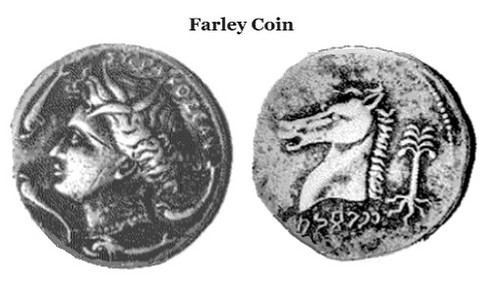
Bronze. Obverse head of Arethusa with four dolphins around. No earring. Legend: S?????S?O?. Reverse horse head and palm tree with five roots. Nonsense legend.
Diagnostics:
- The Carthaginian coin is silver, the Farley coin is bronze.
- The Farley legend
Syracuse
does not appear on genuine Carthaginian coins. - The Farley reverse legend is incorrect.
- The Farley reverse palm tree has roots, unlike the original.
- Original coins are struck; Farley coins are cast.
A Farley Coin is a modern fantasy and not a copy of a real coin. The Arethusa obverse is a general copy of a Syracuse decadrachm. The reverse is similar to a Carthaginian tetradrachm, but with a palm tree with roots not seen on any real coin.
The original coins are struck and silver. The Farley coins are cast and bronze. There should be no reason to attribute the Farley coins as authentic. The holed Farley coins were originally jewelry pieces not matched to a maker or time period.
Dr. Mark McMenamin suggested that the fantasies may have been scattered in the ground to confuse archaeologists. This is not logical since they have not been found at archaeological sites with other objects to provide context.
The number found and the wide distribution suggests that the jewelry pieces were quite common at one time. Some of these jewelry pieces have survived without being buried. While more may be found in the ground, it is likely more can be found in vintage jewelry if people are looking.
Thanks again to Pete for his hard work in compiling, organizing and making sense of all this information. Thanks also to Julia Casey and Bill Daehn for their assistance. We love these numismatic mysteries here at The E-Sylum. Great fun. -Editor
A JANUS COPPER BUTTON?
Here's another enigmatic piece. -Editor
Website visitor Tim Heller writes:
"I stumbled across the article you wrote about the Janus Copper. I was recently metal detecting and found what appears to be one of these coins, however it was made into a button. If you could help in any way to help me see if this could be real?"
It does look like this was made as (or made into) a button. The earlier E-Sylum article is linked below. Here is it side-by-side with the earlier Heritage auction lot image. -Editor
Heritage cataloguer Dave Stone writes:
"This is interesting. Unfortunately, I don't have much to contribute about the new "button" piece. I never saw or heard of anything like it. The obverse doesn't look quite the same as the Janus Copper, although they are certainly similar. The date seems to be positioned higher on the "button" and the D in GODDESS is much lower than the E. Is the "button" struck in copper? Hard to tell from the picture."
What do people make of this? Is such a button known? Pete Smith located this "nickel size" fantasy on eBay. -Editor
To read the complete lot description, see:
STATE of MASS. 1776 GODDESS OF LIBERTY FANSY ISSUE TOKEN 3 FACES
(https://www.ebay.com/itm/204820072838)
THE 1776 JANUS COPPER (https://www.coinbooks.org/v21/esylum_v21n14a12.html)
THE BUTTON MUSEUM (https://www.coinbooks.org/v27/esylum_v27n16a30.html)
VICTOR DAVID BRENNER SCULPTURAL WORKS
We all know Victor David Brenner as the designer of the iconic Lincoln Cent, and for his multiple medals and plaques. But his sculptures are less common and less known. One of his sculptural works is up for sale, and it's a lovely work. -Editor
Victor David Brenner (Lithuanian/American, 1871-1924) bronze sculpture depicting a nude woman or nymph, seated on a rocky bank and looking down at a turtle, while holding the stem of a pond lily in her left hand. Signed "VD Brenner" and dated 1911, with inscription "Cast by Tiffany Studios NY" to side of base. Overall height: 16". Diameter: 11".
Biography: Victor Brenner was best known as a medallion and coin sculptor. His most famous work was the 1909 Lincoln head penny. Born in Lithuania, he trained at the Academie Julian in Paris and came to New York in 1890. He was a member of the National Sculpture Society, the National Arts Club, and the Architectural League. His work is in the collections of the Architectural League in New York, the Metropolitan Museum, the Paris Mint, and the Vienna Numismatic Society. Sources: Donald Martin Reynolds, "Masters of American Sculpture, and Peter Falk, "Who Was Who in American Art".
PROVENANCE: The estate of Delores Farr, Signal Mountain, TN.
To read the complete lot description, see:
Lot 142: V. D. Brenner Bronze Sculpture, Tiffany Studios
(https://www.invaluable.com/auction-lot/V.-D.-Brenner-Bronze-Sculpture,-Tiffany-Studios-142-c-0AD474EA4C)
Dick Johnson submitted his compilation of Brenner sculptural works in 2020 - see the earlier article. Here's an image of his largest work, a monumental public fountain in Pittsburgh. -Editor
To read the earlier E-Sylum article, see:
SCULPTURES BY U.S. COIN DESIGNERS
(https://www.coinbooks.org/v23/esylum_v23n35a20.html)
NOTES FROM E-SYLUM READERS: SEPTEMBER 6, 2020 : Brenner's Three-Dimensional Sculptures
(https://www.coinbooks.org/v23/esylum_v23n36a12.html)
MORE ON VICTOR DAVID BRENNER SCULPTURES
(https://www.coinbooks.org/v23/esylum_v23n37a18.html)
STEPHEN ALBUM RARE COINS AUCTION 49
Here's the press release for Stephen Album Rare Coins upcoming Auction 49. -Editor
 Stephen Album Rare Coins will hold its Auction 49 from June 13-16, 2024, at their offices in Santa Rosa, California. The auction is made up of 4075 lots of Ancient, Islamic, Indian, Chinese, and World Coins. The first two days will be in-person bidding as well as on the internet, while the third and fourth days will be internet-only sessions.
Stephen Album Rare Coins will hold its Auction 49 from June 13-16, 2024, at their offices in Santa Rosa, California. The auction is made up of 4075 lots of Ancient, Islamic, Indian, Chinese, and World Coins. The first two days will be in-person bidding as well as on the internet, while the third and fourth days will be internet-only sessions.
Featured in the auction will be the Dr. Dirk Löer Collection of Chinese Coins, the Almer H. Orr III Collection of World Coins, the Roland Dauwe Collection of the Mint of Qumm, the Howard A. Daniel III Collection of Asian Coins, the Jürgen M. Wilmes Collection of Openwork Charms, the Professor Richard Haiman Collection of World Gold, and the Charles W. Lueders III Collection of Indian and Asian Coins.
Some highlights from the sale follow:
LOT 712: INDIA: MUGHAL:
Jahangir, 1605-1628, gold mohur, Agra, AH1035 year 20, cf. KM-168.1 (rupee), citing both Jahangir and his chief consort Nur Jahan, Persian couplet ba hukm shah jahangir yafta sad zevar // ba nam-e-noor jahan badshah begam zer ("[Coin struck] by the order of Shah Jahangir, [this] gold has a hundred beauties gained with the inscription of the name of Nur Jahan, the Badshah Begum"); extremely rare and unpublished in Krause; two minor edge defects, very slightly bent, with stunning brilliant original lustrous fields! NGC UNC Details, RRR.
Estimated at $80,000 to $100,000
LOT 1582: CHINA: REPUBLIC:
AR dollar, Central Mint, Tientsin, ND (1914), Y-322, L&M-858, K-642, 39mm Regular Strike type, Commemorative for the Founding of the Republic of China; facing bust of Yuan Shih Kai in military attire and tall, plumed hat // value within wreath, a wonderful lustrous mint state example with light peripheral tone! PCGS graded MS64.
Estimated at $50,000 to $60,000
LOT 749: INDIA: SIKH EMPIRE:
AV 1/4 mohur (2.47g), Amritsar, VS1882 (1825), KM-23, a wonderful mint state example; all Sikh gold of Amritsar is extremely rare, aside from the small gold rupees struck at Multan dated VS1905, but fractional gold is of the greatest rarity. There are only about 5 half mohurs filed on CoinArchives, but no quarter mohurs. Herrli cited just over ten known dated for the full mohur, just one year for the half mohur, and only a reference that two dates "have been reported" for the quarter mohur, PCGS graded MS64, RRR.
Estimated at $40,000 to $50,000
LOT 1576: CHINA: REPUBLIC:
AR dollar, ND (1912), Y-320.2, L&M-44A, Li Yuan Hung wearing Wuchang New Army military cap, "H" in CHINA without crossbar "CI IINA", a lovely example with sharp die polish marks and brilliant nearly prooflike luster! PCGS graded MS63, ex Almer H. Orr III Collection.
Estimated at $30,000 to $50,000
LOT 506: ISLAMIC: GHAZNAVID:
Ibrahim, 1059-1099, gilt bronze medallion (70.42g), Ghazna, AH454, 68.5mm; the obverse bears religious legends and the name of the caliph al-Qa'im bi-amr Allah (AH422-467, 1031-1075), the reverse has the name and titles of the Ghaznavid king Ibrahim (AH451-492, 1059-1099) plus the mint and date, Ghazna AH454, plus the "denomination" dinar, as on the regular circulating gold coins; pierced 6 times around the rim for safe honorific attachment to clothing or other objects; VF-XF, RRRR.
Estimated at $20,000 to $25,000
LOT 1408: WORLD: NEPAL:
Girvan Yuddha Vikrama, 1799-1816, AV 4 mohars (duitola asarphi) (23.11g), SE1720 (1802), cf. Rhodes-727/730, struck circa 1849 for the visit of Jung Bahadur Rana to London the following year, a historically significant example of the highest rarity (RRRR)! PCGS graded Specimen 63.
Estimated at $18,000 to $22,000
LOT 967: WORLD: GREAT BRITAIN:
Victoria, 1837-1901, AR crown, 1847, KM-744, S-3883, ESC-288, Bul-2571, 'Gothic' type, UNDECIMO on edge, beautiful multi-color toning, a choice example of this popular type, PCGS graded Proof 63
Estimated at $15,000 to $20,000
LOT 655: ISLAMIC: DURRANI:
Shah Shuja', 2nd reign, 1803-1809, AV mohur (11.03g), Rikab, AH1219, A-3120, KM-742, Whitehead-979 (same dies), with his normal couplet on the obverse, used at all mints except Bahawalpur and Kashmir // mint and date; there is no regnal year; the mint is the military Court mint with the formula zarb-i mubarak-i rikab, "the fortunate mint of Rikab"; Rikab means "stirrup" and refers to the horses used in the military advances; wonderful bold strike, choice XF, RRR
Estimated at $10,000 to $12,000
LOT 47: ANCIENT: ROMAN EMPIRE:
Aelia Verina, empress, 457-484, AV solidus (4.49g), Constantinople, 468-473, S-21465, RIC-607 (Leo I), AEL VERINA AVG, diademed and draped bust right, crowned by Manus Dei // VICTORIA AVGGG, Victory standing left, holding long jeweled cross, star in right field, small dent on reverse, some surface roughness, Choice VF, RRR
Estimated at $7,000 to $10,000
The firm is currently accepting consignments for its milestone Auction 50, which will take place on September 19-22, 2024, as well as for future sales.
To view all the lots in this auction, see:
Steven Album Rare Coins Auction 49
WAYNE'S NUMISMATIC LITERATURE JUNE 9, 2024
I often have a Numismatic Diary article in this space, but with the second part of my library in Saturday's Kolbe & Fanning numismatic literature auction, I thought I'd comment on some of my consigned items. I'll miss them but here's hoping they all find good new homes. -Editor
Lot 303: Armand Champa Library Materials [Champa, Armand]. MATERIALS RELATING TO THE 1994–1995 SALES OF THE ARMAND CHAMPA LIBRARY.
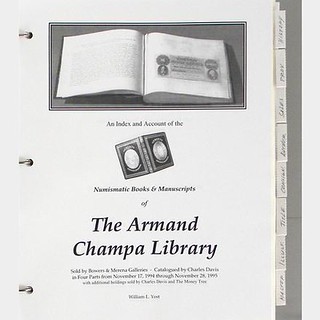 Two three-ring binders including the following: a postcard from George F. Kolbe announcing that he will be offering the Champa Library at auction; promotional materials for the November 1994 Baltimore show at which the first Champa sale was held by Bowers & Merena; the Bowers & Merena announcement of the Champa Library sale; Wayne Homren's invoice for sets of both the softcover and hardcover catalogues; Homren's annotated copies of the first two Champa sales, hand-priced and generally recording buyer numbers, some of which are identified; a copy of the Herman Halpern sale held March 24–25, 1995 alongside the second Champa sale; printed emails and other correspondence regarding the sales, between Homren and John J. Ford, Jr., Chris Karstedt and others; Homren's bid card, handwritten notes, additional printed emails (Wayne was a trend-setter), Champa bookplates, lists of bidders, and so on.
Two three-ring binders including the following: a postcard from George F. Kolbe announcing that he will be offering the Champa Library at auction; promotional materials for the November 1994 Baltimore show at which the first Champa sale was held by Bowers & Merena; the Bowers & Merena announcement of the Champa Library sale; Wayne Homren's invoice for sets of both the softcover and hardcover catalogues; Homren's annotated copies of the first two Champa sales, hand-priced and generally recording buyer numbers, some of which are identified; a copy of the Herman Halpern sale held March 24–25, 1995 alongside the second Champa sale; printed emails and other correspondence regarding the sales, between Homren and John J. Ford, Jr., Chris Karstedt and others; Homren's bid card, handwritten notes, additional printed emails (Wayne was a trend-setter), Champa bookplates, lists of bidders, and so on.
Also included is Bill Yost's third draft and preliminary layout of his unpublished Index and Account of the Numismatic Books & Manuscripts of the Armand Champa Library (dated November 2, 1996). Materials generally fine or nearly so. A fascinating group of ephemeral items relating to the Armand Champa Library sales, accompanied by annotated catalogues and Homren's notes made in preparation for, and immediately after, the sales. Included in the more ephemeral items are printed 1995 emails from the new BiblioNumis-L list being promoted by Harry Bass and Wayne Homren. Yost's never-published work was envisioned to include a history of the collection, provenances, author and dealer index, consignor index, title index, index of illustrations, and a master index. Ex Wayne Homren Library.
A real trip down memory lane. Harry was my first (OK, only) billionaire pen pal. And Armand was a great friend and inspiration. I bought quite a number of lots in the sale, a burst of acquisition before settling down to married life. That sale announcement postcard could be a real rarity - was I the only person to save one? -Editor
To read the complete lot description, see:
Armand Champa Library Materials
(https://bid.numislit.com/lots/view/1-91D1KD/armand-champa-library-materials)
 Lot 323: Connecticut Fiscal Paper
Connecticut. TREASURY OFFICE TRANSFER CERTIFICATE DATED JANUARY 4, 1790 IN INK. Anderson CT 27. Printed form [approximately 19 by 16 cm] filled out by hand, recording the transfer by Joshua Griggs of old notes for new ones. No. 1759; dated January 4, 1790 (printed 1789 date scratched out); signed by Treasurer Peter Colt, with previous signature of Jedediah Huntington crossed out. Docketed on verso. Folded. Very good or better. A piece of 18th-century Connecticut fiscal paper, recording the transfer from Joshua Griggs of
Lot 323: Connecticut Fiscal Paper
Connecticut. TREASURY OFFICE TRANSFER CERTIFICATE DATED JANUARY 4, 1790 IN INK. Anderson CT 27. Printed form [approximately 19 by 16 cm] filled out by hand, recording the transfer by Joshua Griggs of old notes for new ones. No. 1759; dated January 4, 1790 (printed 1789 date scratched out); signed by Treasurer Peter Colt, with previous signature of Jedediah Huntington crossed out. Docketed on verso. Folded. Very good or better. A piece of 18th-century Connecticut fiscal paper, recording the transfer from Joshua Griggs of Army Notes
due June 1, 1785 and June 1, 1787, plus Notes issued February 1781 and May 1783, For which he is entitled to receive Certificates in pursuance to an Act of the General Assembly passed in May 1789.
Ex Wayne Homren Library.
I believe I acquired this at a coin show as an example of colonial money accounting. Neat item of numismatic-related ephemera. -Editor
To read the complete lot description, see:
Connecticut Fiscal Paper
(https://bid.numislit.com/lots/view/1-91D1LH/connecticut-fiscal-paper)
Lot 354: Mysterious American Numismatic Rarity Franklin, C.W. A HANDBOOK OF AMERICAN, GREEK AND ROMAN COINS. Bellevue, 1907. Small 8vo, original brown pebbled cloth, gilt. 119, (1) pages; illustrated throughout, including on variously numbered and unnumbered plates. Spine a bit rubbed, else near fine.
The first copy we have ever handled of this virtually unknown book. John Lupia has investigated the author, Calvin Westley Franklin (1854–1911), and has compiled what information he was able to find about him on his website numismaticmall.com. The rarity of this book is a mystery, given that it includes what appear to be paid advertisements from various banks and businesses, including coin dealers S.H. Chapman and A.C. Gies. One would assume that copies would at the very least have been distributed through these channels, but this appears not to be the case. The unusual mix of coverage (ancient coins and modern American coins) may have contributed to the lack of interest among collectors. While I have not had a chance to investigate the illustrations used in this book, they look familiar and I would not be at all surprised to find them elsewhere. An intriguing volume. Ex John Beck Library; ex Wayne Homren Library.
I acquired this early on in my numismatic literature journey. Fellow Western Pennsylvania Numismatic Society member Harry Colborn tipped me off to an estate sale with multiple box lots of coin books. He was interested in large cent literature; I bought all of the lots and sold Harry the copper books. The consignment turned out to be from the family of John A. Beck, the banker and voracious coin buyer. I never knew what to make of this unusual item either, but I've never encountered another copy. Rare and perhaps unique. -Editor
To read the complete lot description, see:
Mysterious American Numismatic Rarity
(https://bid.numislit.com/lots/view/1-91D1N7/mysterious-american-numismatic-rarity)
Lot 359: Hardcover Gilbert & Elder on 1796 Cents Gilbert, E., and Thomas L. Elder. THE VARIETIES OF THE UNITED STATES CENTS OF 1796. New York, 1909. 4to, original brown cloth, gilt. (16) pages (last leaf blank); 2 fine photographic plates of cents. Three printed supplement sheets, describing varieties 22–31 and 33–40 (skipping 32), laid in. Hinges a bit weak, but holding; Very good or better. A nice copy of the Special Hardbound Edition. One of only 300 copies printed, most of which were bound in card covers.
In a letter sold in our June 1990 Adams sale, George Clapp wrote: Rud Kohler wrote me that Gilbert once told him that he had loaned his manuscript of 1796 to Elder who wished to look it over, and the first thing he knew, Elder had published it without consulting him.
Sheldon confirms this and notes that Gilbert had the material for a first-rate monograph. It was either not ready or not intended for publication and was badly edited.
This copy includes all three printed supplements, covering variety Nos. 22–25, 26–31 and 33–40. Somehow, No. 32 was never printed. Ex Dr. James O. Sloss Library; ex Wayne Homren Library.
As the youngster of the group, I had the opportunity over the years to purchase entire libraries when club members passed away. Jim Sloss's widow Sarann was a delight to speak with. I visited the Sloss home in Beaver, PA a couple of times buying catalogs and books, most of which stayed in my library for decades. -Editor
To read the complete lot description, see:
Hardcover Gilbert & Elder on 1796 Cents
(https://bid.numislit.com/lots/view/1-91D1NH/hardcover-gilbert-elder-on-1796-cents)
Lot 383: Rare 1866 Cincinnati Coin Sale Broadside Hubbard, S.G. [auctioneer]. COINS, BOOKS, &C. AT AUCTION. ON FRIDAY EVENING, NOVEMBER 9TH, 1866, AT 7 O'CLOCK, WILL BE SOLD THE CABINET OF COINS AND A PORTION OF THE PRIVATE LIBRARY OF THE LATE DR. G.T. COLLINS. THE COINS CONSIST OF AMERICAN, ENGLISH, ROMAN AND GRECIAN, COPPER AND SILVER, SOME OF WHICH ARE RARE. AMONG THE BOOKS ARE SOME THAT ARE RARE AND VALUABLE. ALSO, A GOLD WATCH, MAGNIFYING GLASSES, &C. (Cincinnati), November 9, 1866. Broadside [approximately 48.5 by 32 cm]. 209 numismatic lots + (54) lots of books, etc. Attractively framed in brown wood with gilt interior border using museum glass. Four fold-marks; some browning. Very good or better.
 A marvelous numismatic broadside, already attractively framed and ready to serve as wall decoration for the dedicated coin collector or numismatic bibliophile. American coins in the sale include an assortment of colonials and state coppers, Washingtonia, a run of half cents (including 1811) and a
A marvelous numismatic broadside, already attractively framed and ready to serve as wall decoration for the dedicated coin collector or numismatic bibliophile. American coins in the sale include an assortment of colonials and state coppers, Washingtonia, a run of half cents (including 1811) and a Martha Washington Half Dime.
A run of Roman portrait coins are included, many of them in silver; as well as Greek coins, including two in gold. English coins, from the Anglo-Saxon period to Victoria, followed. Two numismatic works are featured in the book section, Dickeson's American Numismatic Manual and Humphrey's Coin Collector's Manual.
The only other copy of this broadside that we have handled was in the second Bass sale (Kolbe Sale 77, lot 342), where an example brought $2400 hammer. We know of no other copy having been sold, with the Fuld, Champa, Ford and Newman Libraries all lacking a copy. The ANS Library holds the only other copy known to us, and that is permanently off the market. Attinelli 45. McKay 10166.
I'll really miss this one. Purchased already framed from Charlie "Cheech" Litman at the Pittsburgh Coin Exchange on my lunch break one day, it hung next to the desk in my library for decades. Perfect for us numismatic bibliophiles. -Editor
To read the complete lot description, see:
Rare 1866 Cincinnati Coin Sale Broadside
(https://bid.numislit.com/lots/view/1-91D1OT/rare-1866-cincinnati-coin-sale-broadside)
Lot 421: The Donald M. Miller Archives Miller, Donald M. ARCHIVAL MATERIAL INCLUDING ANNOTATED PUBLICATIONS FROM THE LIBRARY OF DONALD MILLER. Includes:
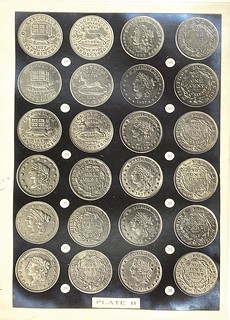 a early binder containing 54 sheets, being a typewritten catalogue of Pennsylvania tokens, almost certainly not by Miller, with handwritten notes by Miller expanding the original text;
a early binder containing 54 sheets, being a typewritten catalogue of Pennsylvania tokens, almost certainly not by Miller, with handwritten notes by Miller expanding the original text;
a binder containing 61 sheets of handwritten notes by Miller on 19th-century American political tokens;
Joseph Barnet's copy of the 1899 second edition of Lyman Low's Hard Times Tokens, acquired by Miller in 1949 from David Bullowa at the same time that Miller acquired Barnet's collection;
a disbound copy of the 1899 second edition of Low, bound with the 1906 supplementary article as published in the American Journal of Numismatics, as well as W.F. Dunham's Instant Finding List, notes on the Levick sale, and an original set of Edgar Adams's 15 Photographs of Hard Times Tokens, Numbered According to Low (c. 1913);
Thomas H. Isitt's lightly annotated copy of the 1899 second edition of Low, bound in leather with the 1906 Supplement;
correspondence between Donald Miller and Charles Kappan, E.E. Rogers, E.A. Rice, Charles McSorley, William Dewey, James Fawcet and others;
miscellaneous notes on varieties of American tokens, with pricing information; notes on collections of tokens and published materials about them;
an inventory of Miller's numismatic library;
a worn copy of the April 1870 issue of the American Journal of Numismatics, including J.N.T. Levick's early Description of the Hard Times Tokens of 1837.
Condition varies, with some of the material in binders coming loose. Generally very good or better unless otherwise noted.
Donald Miller is probably best-known for being the author of A Catalogue of U.S. Store Cards or Merchants Tokens (1962), which was a revision and expansion of Edgar Adams's earlier work on the subject. Miller formed extraordinary collections of American tokens, most particularly Hard Times Tokens and 19th-century store cards. His interest was broad, however, and there are materials here relating to Washingtonia, shell cards, politicals,
and other tokens. His collections were mostly sold privately, and his printed publications are few in number, making this small archive of considerable interest to the token specialist. Ex Donald M. Miller Library; ex Wayne Homren Library.
The largest numismatic library I ever purchased belonged to Don Miller of Indiana, PA. I'd visited him at his home a couple times, and his widow contacted me after his death. We had very similar numismatic interests - about 85% of the book titles were already in my library, and I sold the duplicates through The Money Tree. Among the unique items I kept was this wonderful group of ephemera and archival material.
Interesting aside - the Millers lived in the home movie star Jimmy Stewart grew up in. -Editor
To read the complete lot description, see:
The Donald M. Miller Archives
(https://bid.numislit.com/lots/view/1-91D1QX/the-donald-m-miller-archives)
Lot 433: Fantastic 1804 Dollar Signed by All Four Authors & Researchers
Newman, Eric P., and Kenneth E. Bressett. Associates in Research, Walter H. Breen and Lynn Glaser. THE FANTASTIC 1804 DOLLAR. Second printing. Racine: Whitman, 1962. 8vo, original brown textured cloth lettered in silver. 144 pages; illustrated. Signed by all four authors and associates on the title page. Fine. The only copy we recall handling that has been signed by all four authors and associates in research
: Newman, Bressett, Breen and Glaser. Laid in is a printout of an email exchange between Ken Bressett and Wayne Homren, discussing this copy. Ex Wayne Homren Library.
I'm proud of this accomplishment. I was quite lucky to know three of the four (all legends of American numismatics) and get their signatures in person. I had to track down Lynn Glaser and got him on the phone one day. I introduced myself and asked if he'd be willing to sign my copy as well. He agreed, and I shipped it off to him. It returned with the fourth signature, and as far as I know this is the only copy of this classic book thus signed. -Editor
To read the complete lot description, see:
Signed by All Four Authors & Researchers
(https://bid.numislit.com/lots/view/1-91D1RL/signed-by-all-four-authors-researchers)
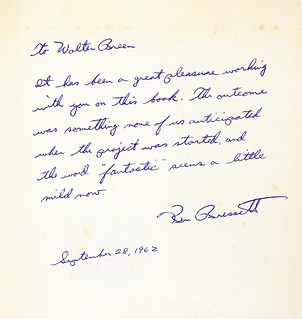 Lot 434: Walter Breen's Inscribed Copy
Newman, Eric P., and Kenneth E. Bressett. Associates in Research, Walter H. Breen and Lynn Glaser. THE FANTASTIC 1804 DOLLAR. Second printing. Racine: Whitman, 1962. 8vo, original brown textured cloth lettered in silver. 144 pages; illustrated. Signed, with a lengthy inscription, to Walter Breen by Ken Bressett on the front flyleaf. Minor spotting; somewhat musty. Very good. An important association copy, inscribed by author Ken Bressett of Water Breen, who is named on the title page along with Lynn Glaser as an
Lot 434: Walter Breen's Inscribed Copy
Newman, Eric P., and Kenneth E. Bressett. Associates in Research, Walter H. Breen and Lynn Glaser. THE FANTASTIC 1804 DOLLAR. Second printing. Racine: Whitman, 1962. 8vo, original brown textured cloth lettered in silver. 144 pages; illustrated. Signed, with a lengthy inscription, to Walter Breen by Ken Bressett on the front flyleaf. Minor spotting; somewhat musty. Very good. An important association copy, inscribed by author Ken Bressett of Water Breen, who is named on the title page along with Lynn Glaser as an Associate in Research.
Bressett's inscription, dated September 28, 1962, reads, To Walter Breen, It has been a great pleasure working with you on this book. The outcome was something none of us anticipated when the project was started, and the word ‘fantastic' seems a little mild now.
Ex Wayne Homren Library.
As the consignor I'm naturally inclined to overvalue my own material, but I'd like to think I'm not the only bibliophile to appreciate this association copy inscribed by a fellow author and researcher. One of the most important books in American numismatics is also widely available, but a scant few have such contemporary inscriptions. One of the last additions to my library before deciding to consign it, I paid multiples of the estimate in this sale. -Editor
To read the complete lot description, see:
Walter Breen's Inscribed Copy
(https://bid.numislit.com/lots/view/1-91D1RN/walter-breens-inscribed-copy)
Lot 455: An A.M. Smith Corkscrew
Smith, A.M. STRAIGHT-PULL CORKSCREW WITH WOODEN GRIP ADVERTISING A.M. SMITH'S WINE AND SPIRITS BUSINESS. Minneapolis, late 1800s–early 1900s. 11.5 cm iron shaft with 9 cm wooden grip. Printed text promoting Smith's business at 247–249 Hennepin Avenue, Minneapolis. Shaft lightly rusted; grip text legible. Very good. A neat memento of one of the more prominent American numismatic authors of the later 19th century. According to Pete Smith's American Numismatic Biographies, A.M. Smith moved to Minneapolis in 1886, where he engaged successfully in the wine trade. The wooden grip of this promotional corkscrew advertises the availability of Wines, Brandies, Whiskies, Pure Olive Oil, Honey, Ale, Porter, Beer, Cigars.
Ex Wayne Homren Library.
A gift from Pete Smith himself, this decorated one of my library shelves for decades. Neat association item. -Editor
To read the complete lot description, see:
An A.M. Smith Corkscrew
(https://bid.numislit.com/lots/view/1-91D1ST/an-am-smith-corkscrew)
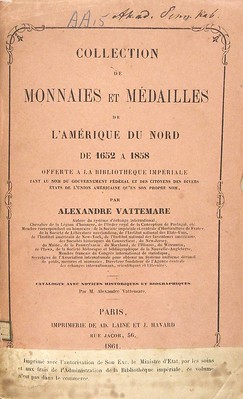 Lot 486: Signed by Vattemare
Vattemare, Alexandre. COLLECTION DE MONNAIES ET MÉDAILLES DE L'AMÉRIQUE DU NORD DE 1652 À 1858, OFFERTE A LA BIBLIOTHÈQUE IMPÉRIALE TANT AU NOM DU GOUVERNEMENT FÉDÉRAL ET DES CITOYENS DES DIVERS ÉTATS DE L'UNION AMÉRICAINE QU'EN SON PROPRE NOM... CATALOGUE AVEC NOTICES HISTORIQUES ET BIOGRAPHIQUES. Paris: Imprimerie de Ad. Lainé et J. Havard, 1861. 12mo, later black quarter morocco with marbled sides; spine ruled and lettered in gilt; original printed paper covers, with printed hors commerce label, bound in. 134, (2) pages. Original postal wrap showing the address of P.O. van der Chijs, signed by Vattemare and bearing the ink stamp of the Systèm International and the handwritten postage paid, trimmed and mounted to opening blank. Very good or better; binding fine. A fascinating copy, this was sent by Vattemare to Dutch numismatist Pieter Otto van der Chijs...
Lot 486: Signed by Vattemare
Vattemare, Alexandre. COLLECTION DE MONNAIES ET MÉDAILLES DE L'AMÉRIQUE DU NORD DE 1652 À 1858, OFFERTE A LA BIBLIOTHÈQUE IMPÉRIALE TANT AU NOM DU GOUVERNEMENT FÉDÉRAL ET DES CITOYENS DES DIVERS ÉTATS DE L'UNION AMÉRICAINE QU'EN SON PROPRE NOM... CATALOGUE AVEC NOTICES HISTORIQUES ET BIOGRAPHIQUES. Paris: Imprimerie de Ad. Lainé et J. Havard, 1861. 12mo, later black quarter morocco with marbled sides; spine ruled and lettered in gilt; original printed paper covers, with printed hors commerce label, bound in. 134, (2) pages. Original postal wrap showing the address of P.O. van der Chijs, signed by Vattemare and bearing the ink stamp of the Systèm International and the handwritten postage paid, trimmed and mounted to opening blank. Very good or better; binding fine. A fascinating copy, this was sent by Vattemare to Dutch numismatist Pieter Otto van der Chijs...
Vattemare's System of International Exchanges was initially aimed at the exchange of duplicate books between libraries, and was later extended to include works of art, maps, natural history specimens, coins, medals and other similar objects. He came to America in 1839 and again in 1847, and was granted funds by Congress and by several state legislatures to further his scheme, which met with greater success here than in Europe. This elusive 1861 work describing American coins, medals and tokens from 1652 to 1858 was written to complement the collection given to the Bibliothèque Impériale (Nationale) in the name of the government and citizens of the United States. Following an interesting historical overview, from colonial issues to pioneer gold, some 381 pieces are described in detail. P.O. van der Chijs was the foremost Dutch numismatist of his day; some of the pencil annotations record additional American coins in the numismatic cabinet at Leiden.
Alexandre Vattemare is recognized among American numismatists as one of the fathers of the discipline in the New World, having assembled the first comprehensive collections of American coins, medals, and paper currency, and produced the first comprehensive catalog of American numismatics.
— Alan Stahl, in The Extravagant Ambassador: The True Story of Alexandre Vattemare, the French Ventriloquist Who Changed the World. Ex P.O. van der Chijs Library; ex Schulman Numismatic Library; George F. Kolbe 1997 fixed price list; ex Wayne Homren Library.
Another association copy with a marvelous pedigree, signed by the greatest numismatist in early America. I've always gotten goosebumps handling this one.
Good luck in the sale, everyone. -Editor
To read the complete lot description, see:
Signed by Vattemare
(https://bid.numislit.com/lots/view/1-91D1UJ/signed-by-vattemare)
ROYAL AUSTRALIAN MINT HOSTS COIN SWAP
In the news-from-down-under department, this article reports on a fun "coin swap" sponsored by the Royal Australian Mint. -Editor
This weekend, it's the Royal Australian Mint's Canberra Coin Swap which is drawing collectors, known as numismatists, to the national capital.
Attendees bring along cash and coins and swap them for circulating coloured and commemorative coins which have, until now, been uncirculated.
And with this being first time the event has been held since the pandemic, there's plenty of pent up demand.
CEO of the Royal Australian Mint Leigh Gordon said this coin swap was focused on recently-produced coins from the "last few years".
That includes those with the effigy of King Charles as well as coins commemorating the hard work of first responders including firefighters.
The premise of the swap is simple.
"It's a coin swap, so it's cash for cash," he said. "You give us 10 dollars cash and you get 10 dollars worth of coins."
But Mr Gordon said there are specific coins which stand out.
"There's a variety of stories that really strike a chord with people. We do some military coins; we do some other society-based coins," he said.
"Certainly, there's an opportunity for people to grab a memento for an event that they mightn't really be able to get to themselves."
Despite the pandemic having impacted coin and cash usage in Australia and globally — numismatists' love for coins is only increasing.
Mr Gordon said almost a quarter of Australians would call themselves a coin collector.
Many collectors actively sought out specific coins to complete their collection, Mr Gordon said.
To read the complete article, see:
Coin enthusiasts travel across the country for the Royal Australian Mint's coin swap
(https://www.abc.net.au/news/2024-06-02/coin-collectors-canberra-event-royal-mint/103923174)
THE OLYMPIC GAMES THAT AREN'T RECOGNIZED
This article from the Künker auction house discusses some little-known Olympic history - a medal from Olympic games held but no longer recognizes. -Editor
In 1906, the IOC and the country of Greece invited athletes from all over the world to the Olympic Games in Athens. The Games had a lasting impact on the ceremonies surrounding the sporting showdown, even though the IOC no longer recognizes these Olympics today. A winner's medal from the Games will be auctioned by Künker on 18 June 2024.
On 18 June 2024, the Künker auction house in Osnabrück will offer a ‘gold' medal from the 1906 Olympics in Athens, of which probably only 78 specimens were produced. As was customary at the time, the medal is of course not made of pure gold, but gilded silver. Interestingly enough, the 1906 Olympics do not appear on the IOC's list of Games. We explain why these Olympic Games are no longer recognized as such.
Rome was to host the Games in 1908, but the Italian organizing committee was dissolved in January 1906. Therefore, the Olympic idea was almost dead when the Greek government announced its plans to hold the Olympic Games in 1906, following Coubertin's proposal of two types of alternate games. The IOC recognized the opportunity of such games and wholeheartedly supported Greece in this effort – except for Pierre de Coubertin. It seems that the latter was more interested in getting his way than in turning the Olympic idea into a success story.
With the 1906 Olympics, Greece wanted to continue the tradition of the highly successful first Olympics. This was also reflected by the medals, which were produced by the Monnaie de Paris. Every detail of these medals is the same as on those for the first Olympic Games. On the obverse we can see the head of Zeus Olympios, holding a Nike on a globe in his right hand. The reverse presents a view of the Acropolis seen from the Panathenaic Stadium. Only the year on the reverse was adapted, otherwise the legend is identical to that of 1896: International Olympic Games in Athens 1906 (translated).
A gold, a silver and a bronze medal were created for each of the 78 competitions. Like the piece offered by Künker, the gold medals were not made of pure gold but of gilded silver.
The 1906 Olympics became a great success: 900,000 fans cheered on 854 athletes from 20 countries on four continents. For comparison: there were ‘only' 241 athletes at the 1896 Games.
In fact, it can be said that it was the 1906 Games that really kick-started the Olympic movement. It was only after this great success that the British Olympic Association decided in the autumn of 1906 to take over the organization of the 1908 Olympics.
To read the complete article, see:
The Olympic Games That Are No Longer Recognized
(https://www.kuenker.de/en/information/presseinformationen/aktuelle-mitteilungen/557)
THE FIRST PAPER MONEY OF VENEZUELA
Stack's Bowers Director of Consignments & Senior Numismatist Dennis Hengeveld published an article on the earliest paper money of Venezuela. -Editor
The notaphilic history of Venezuela starts in 1811, shortly after seven (out of ten) provinces of the Spanish colonial Captaincy General of Venezuela declared their independence in July of that year. Despite being very short-lived (the First Republic of Venezuela ceased to exist in late July of 1812, just over a year after it was declared), the first independent government still managed to issue its own banknotes. These banknotes were the first printed paper money in South America and are historically extremely significant.
When it comes to the paper money issued by the First Republic of Venezuela the Pick catalog is incomplete. There were three separate emissions of paper money in 1811 and 1812. These different emissions (as listed in the Marcano catalog), can be identified by their signatures. The first was issued pursuant to the law of 27 August 1811, and consisted of 1 Peso, 2 Pesos, 4 Pesos, 8 Pesos and 16 Pesos notes (these are Pick-4 to Pick-8). Just a few months later, there was a shortage of small change, and a 2 Reales or 1/4 Peso note was introduced, which is Pick-2, issued pursuant to the law of 29 November 1811. Then, another series of 1 Peso to 16 Pesos notes were issued according to the decree of February 7, 1812. These are not separated in Pick except for the 1 Peso, which had a minor design change, and is listed as Pick-4A.
The notes were printed in Caracas using engraved wood plates on thick, handmade paper. There is typically a watermark visible, ranging from simple lines to various words, although on most surviving notes only part of a watermark is visible. During later printings the paper quality deteriorated as quantity became more important than quality. The design of the notes was simplistic, and except for signatures on the back on some denominations they were uniface. The main design element is a seal which included the text Pena de Muerte al Falsificador
(Death Penalty to the Counterfeiter). There is also a reference to the first year of independence.
The Banknote Book states that the earliest notes were hand-signed, but most seen today have a stamped signature. As an anti-counterfeit measure a complicated numbering system was used on all notes but the 2 Reales. The numbering was not fully deciphered until the 1990s (by Andrés Núñez and later revised by Tomás Stohr). While the notes lacked financial backing and were easily counterfeited (and not popular with the general public as a result) they still represent the earliest paper money for Venezuela and South-America as a whole. After the First Republic of Venezuela fell in 1812, they were quickly withdrawn and all denominations are rare today.
Several examples of this rare first issue are part of the Rio Arauca Collection of Venezuelan Paper Money, offered in our August 2024 Global Showcase Auction. The deadline is rapidly approaching but we are still taking consignments of notes from the Americas to be offered in this sale. To start the consignment process, please contact Stack's Bowers Galleries at 800-458-4646 or email Dennis Hengeveld at Dennis@stacksbowers.com.
To read the complete article, see:
THE FIRST PAPER MONEY OF VENEZUELA
(https://stacksbowers.com/the-first-paper-money-of-venezuela/)
KING CHARLES III BANKNOTES ISSUED
A number of readers forwarded articles on the new King Charles III banknotes. Kavan Ratnatunga passed along these images from the Bank of England. People began queuing up at 7am. -Editor
Kavan adds:
"This page has a video that was an interview with the collector who was first in the queue."
To read the complete article, see:
'Historic moment': King Charles banknotes enter circulation
(https://www.itv.com/news/2024-06-04/all-change-as-king-charles-banknotes-enter-circulation)
Howard Berlin passed along this one. -Editor
Banknotes bearing a portrait of King Charles entered circulation in Britain on Wednesday, almost two years after he succeeded the late Queen Elizabeth II as head of state.
Charles' image will appear on the new £5, £10, £20 and £50 bills, as existing notes featuring his mother will continue to circulate.
"This approach is in line with guidance from the Royal Household, to minimize the environmental and financial impact of this change," the Bank of England said.
"This means the public will begin to see the new King Charles III notes very gradually."
Coins with the King's portrait entered circulation in December 2022, a few months after the death of Elizabeth II.
To read the complete article, see:
UK: King Charles banknotes enter circulation
(https://www.dw.com/en/uk-king-charles-banknotes-enter-circulation/a-69271225)
And one from David Pickup. Thanks, everyone. -Editor
Banknotes featuring the portrait of Queen Elizabeth II, will remain legal tender, and can continue to be used. There is no need to exchange current banknotes for the new King Charles III notes.
We recognise that people may be interested in seeing the new notes, and have therefore put in place temporary facilities to allow people to obtain a limited value of the King Charles III banknotes - there will be a limit per person.
To read the complete article, see:
King Charles III banknotes
(https://www.bankofengland.co.uk/banknotes/king-charles-banknotes)
TOMMY THOMPSON IS STILL IN JAIL
For those who've lost track, this article discusses the unusual case of S.S. Central America figure Tommy Thompson. -Editor
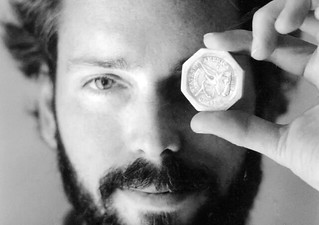 Imagine spending more than eight years in a federal prison with no right to a jury trial or a court-appointed attorney, serving an indefinite sentence. This is how the judicial civil contempt power works, and deep-sea explorer Tommy Thompson — who has been held on civil contempt charges since 2015 — has brought the issue to light.
Imagine spending more than eight years in a federal prison with no right to a jury trial or a court-appointed attorney, serving an indefinite sentence. This is how the judicial civil contempt power works, and deep-sea explorer Tommy Thompson — who has been held on civil contempt charges since 2015 — has brought the issue to light.
Thompson's story dates back to 1989, when he made the greatest treasure find of the century: locating the SS Central America. The sunken ship was carrying the spoils of California's gold rush when it sank in 1857, yielding a treasure worth upward of $765 million in 2024 dollars. Even more amazing than finding the wreck was Thompson's ability to precisely salvage items in nearly 8,000 feet of water.
However, legal battles around the wreck ensued for decades, driven by 39 insurance companies that claimed interest in the items, as well as investors who were dissatisfied with the timeliness of their return on the investment. Thompson was ordered to sit for a debtor's examination that would help these investors collect on the debt due to his alleged mismanagement
of the recovery. After initially participating in a 319-page deposition, Thompson refused to sit for a second deposition, and his attorney invoked Thompson's Fifth Amendment rights to be silent and not answer additional questions.
A U.S. district court judge then held Thompson in civil contempt in 2015. Since then, there has been no meaningful change. Thompson is now 72 years old, in a wheelchair, and not receiving the medical treatment he needs. To make matters worse, in 2022, the U.S. district court judge began initiating an additional criminal contempt of court proceeding/show cause hearing because of Thompson's inability to retain or clearly communicate about formally having an attorney.
In 2015, the U.S. district court judge initially stated that he would assess Thompson every 60 days. But, in the past year, the judge has held zero compliance hearings for Thompson. Meanwhile, Thompson was recently attacked in his jail cell by another inmate. He is simply left to rot in the gallows and, with each day, it seems far more likely that age and time will resolve his case with a death certificate before constitutional diligence occurs.
Many people take solace in the disputes our judicial system gets right, but far too few people spend their time objectively analyzing what it gets wrong. Yet, even federal and Supreme Court justices have highlighted issues with the contempt power — on the lack of meaningful notice, due process rights for the accused, firm guidelines on incarceration limits and structural/separation of power considerations.
To read the complete article, see:
Why is this treasure hunter still sitting in jail?
(https://www.tampabay.com/opinion/2024/06/04/why-is-this-treasure-hunter-still-jail/)
To read earlier E-Sylum articles, see:
REPORTER'S THOUGHTS ON TOMMY THOMPSON'S CAPTURE
(https://www.coinbooks.org/esylum_v18n15a10.html)
THE RISE AND FALL OF TOMMY THOMPSON
(https://www.coinbooks.org/v26/esylum_v26n16a32.html)
TOMMY THOMPSON'S LEGAL LIMBO
(https://www.coinbooks.org/v26/esylum_v26n26a27.html)
MAGNET FISHING YIELDS $100,000 IN CASH
Everyone likes finding treasure. These New York magnet fishers pulled up a small safe with stacks of hundred dollar bills. Thanks to Paul Horner for passing this along. -Editor
James Kane has used a powerful magnet to fish all manner of junk from New York City waterways, but he says the stacks of $100 bills he pulled from a safe were something else entirely.
The couple estimates that the safe contained as much as $100,000, though the bills were partly decomposed and stuck together.
The bills featured the 3D security ribbon that indicates recent vintage, but the safe bore no clues to a rightful owner.
Kane and Agostini said they called the police to report their discovery and were told there was no evidence of a crime.
They gave it to us, as, I guess you call it a finders keepers thing,
Kane said.
People who dabble in the hobby heave long ropes into the water attached to powerful magnets, some capable of staying latched to objects weighing 2,000 pounds (907 kilograms). They drag the lines through water and muck, hauling up objects that would likely go unfound by a beachcomber with a metal detector.
Kane, 40, said he and Agostini, 39, plan to take their soggy money to the Bureau of Engraving and Printing in Washington to redeem it, though he acknowledged some portion of the bills will likely be too damaged to recover.
To read the complete articles, see:
New York magnet fisher catches safe full of soggy $100 bills, he says
(https://apnews.com/article/magnet-fisher-catches-cash-filled-safe-d5a1ddb6a5accbf65542dfbab444c0f6)
Queens couple finds safe with estimated $100k in cash while 'magnet fishing'
(https://ny1.com/nyc/all-boroughs/news/2024/06/01/-magnet-fishing--queens-couple-finds-safe-full-of-cash#)
FEATURED WEBSITE: RHODE ISLAND CURRENCY
This week's Featured Website is Rhode Island Currency. Found via News & Notes from the Society of Paper Money Collectors (Volume IX, Number 51, June 4, 2024).
Thank you for visiting this website. It contains various types of banknotes and other pieces of ephemera from the state of Rhode Island, from colonial days to modern times. Please do not take any banknote images for your own use. If you have any questions, please contact me at collector@ricurrency.com and I will try to help.
This website consists of two different types of pages: displays of single pieces of currency and longer form profiles of banks and other types of institutions.
For the pages where a single piece of currency is displayed, the first number is the date of issue or when it was likely printed. For obsolete notes (from 1800 to the 1860s), this will be followed by a classification number starting with RI
from James A. Haxby's Standard Catalog Of United States Obsolete Bank Notes (1782-1866). In most cases, this will be followed by a Durand number. Roger H. Durand's Obsolete Notes And Scrip of Rhode Island and The Providence Plantations is a definitive and instrumental work for the study of the state's paper issues.
For banknotes from the national banking era (1863-1935), the date of the series will be followed by the Friedberg number and then the official bank charter number.
For profile pages, I have used the original name that the institution was organized under. If such enterprises were reorganized as national banks, I will note this fact in the description but not use a separate page for the bank's currency unless that name is completely different, ie. Rocky Point Bank becoming the National Exchange Bank of Conimicut (by the way, these names are both made up).
The value of such banknotes varies wildly. Some pieces are very common and will fetch only a few dollars on eBay.



